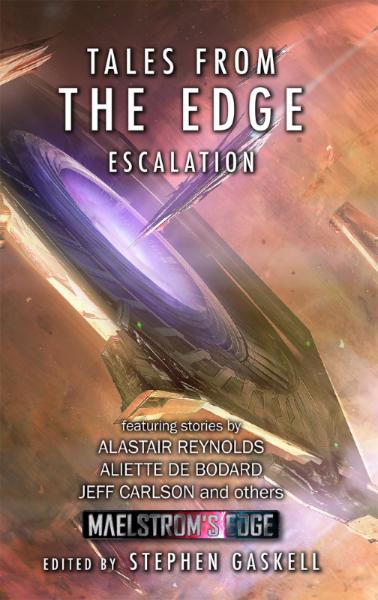Print on Demand Mission Cards now available!
Posted on Wednesday Dec 03, 2025 at 05:00pm in Gaming
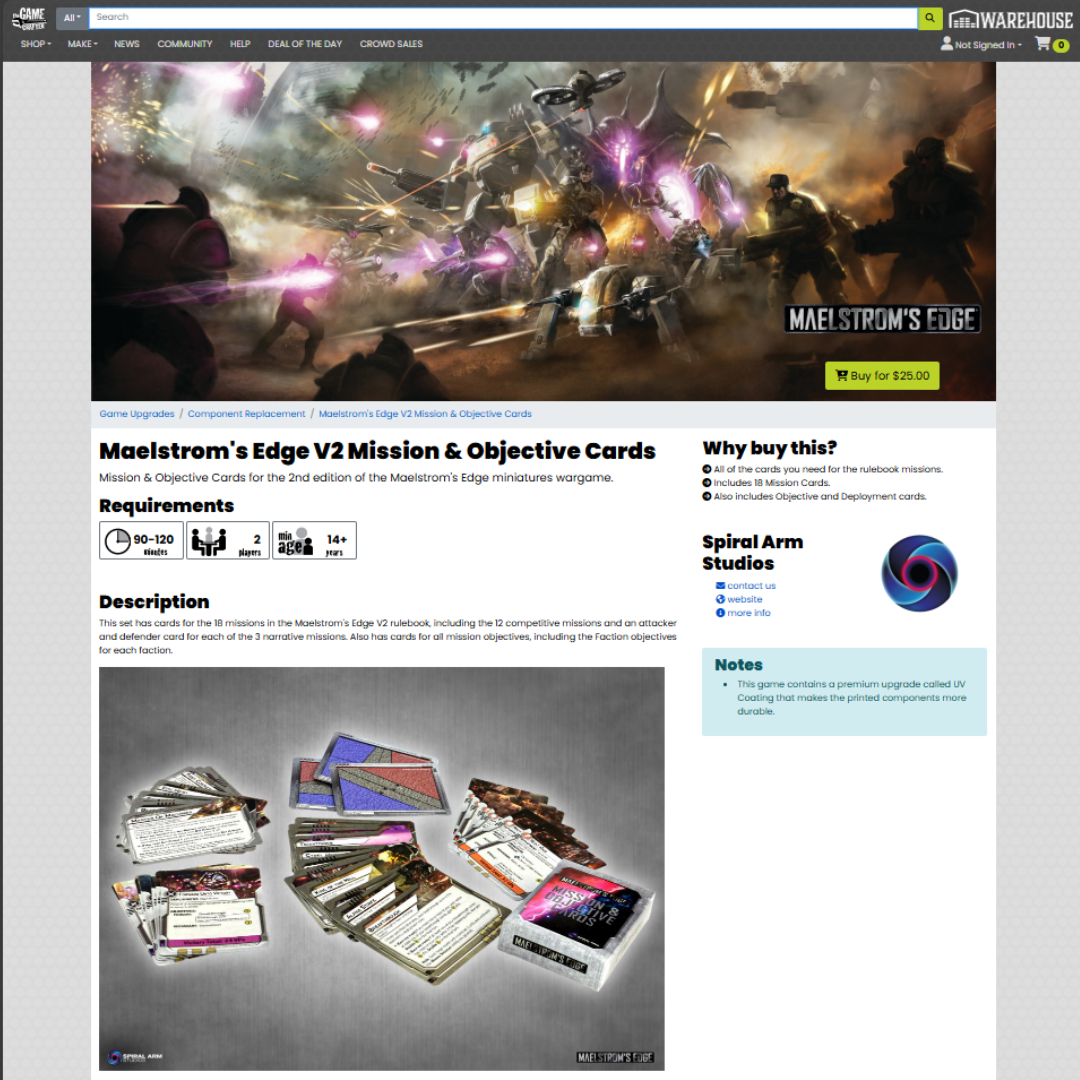
The pack comes in a handy storage box, and is comprised of 54 cards including:
- all of the Competitive and Narrative missions from the V2 rulebook,
- a full set of Objective cards covering all of the various mission objectives from the rulebook,
- cards for all current Faction Objectives,
- and three double-sided Deployment Map reference cards.
Grab yours now from the Game Crafter website here!
Get the rules now!
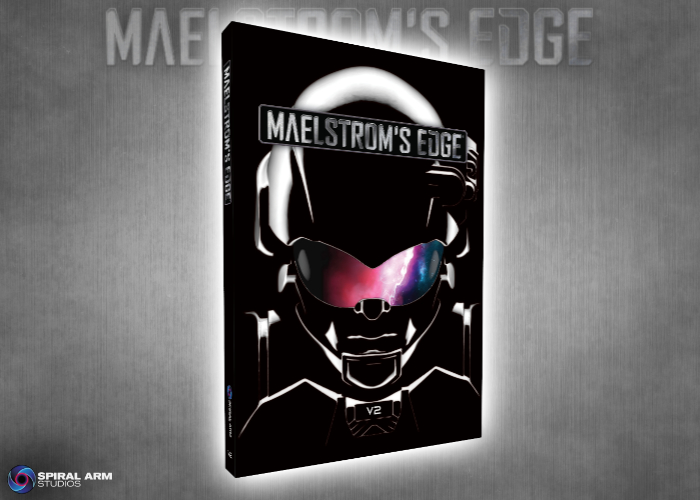
The new V2 rulebook is available in the Maelstrom's Edge webstore now. You can also check out the V2 Rules Downloads section for PDF rules downloads, and the V2 Rules Articles section for some insights into the Maelstrom's Edge rules.
Stay Tuned for more!
Force Spotlight - 50 point Karist Enclave Starter Force
Posted on Friday Nov 28, 2025 at 05:00pm in Models
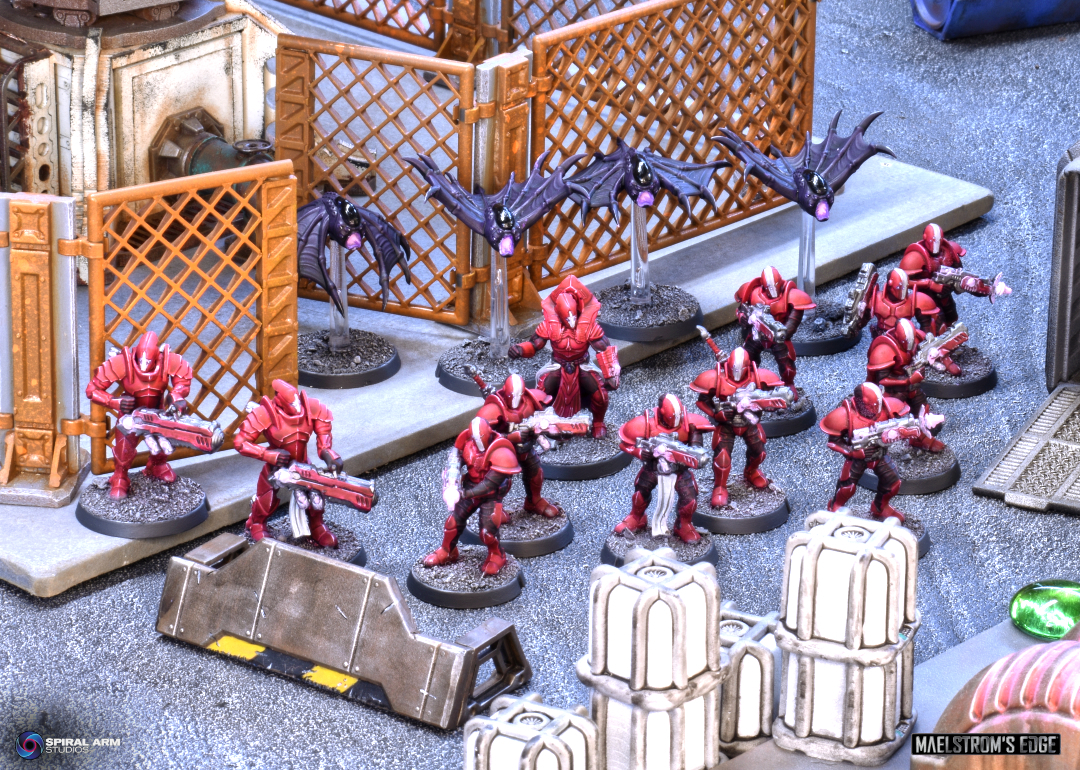
Force Spotlight - 50 point Kaigus Pact Starter Force
Posted on Thursday Nov 20, 2025 at 05:00pm in The Kaigus Pact
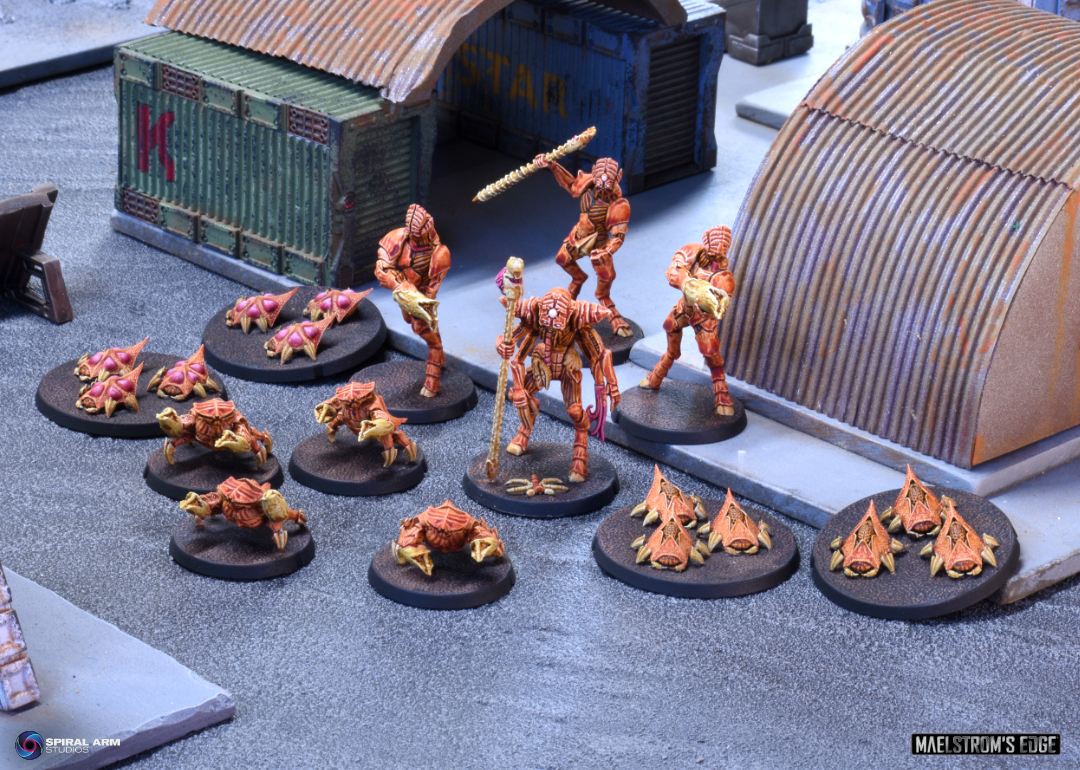
First Encounter - a 50pt Starter Force Battle Report.
Posted on Wednesday Nov 12, 2025 at 05:00pm in Gaming
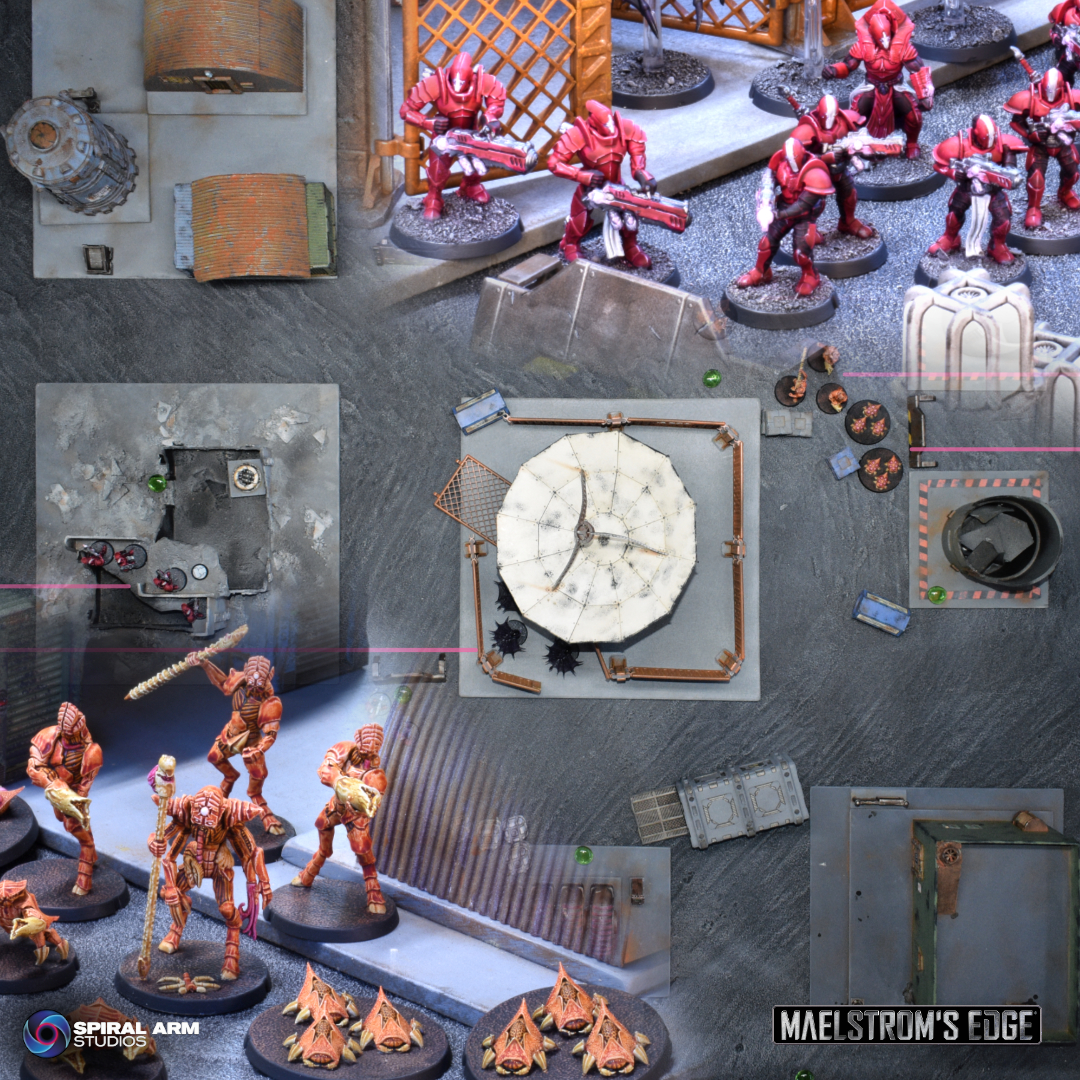
A new Maelstrom's Edge V2 battle report, using the Kaigus Pact and Karist Enclave Faction Starter Sets in a 50 point Forward Unto Victory mission! Check it out here!
New Kaigus Pact Kits Arrive!
Posted on Monday Nov 03, 2025 at 05:00pm in Models
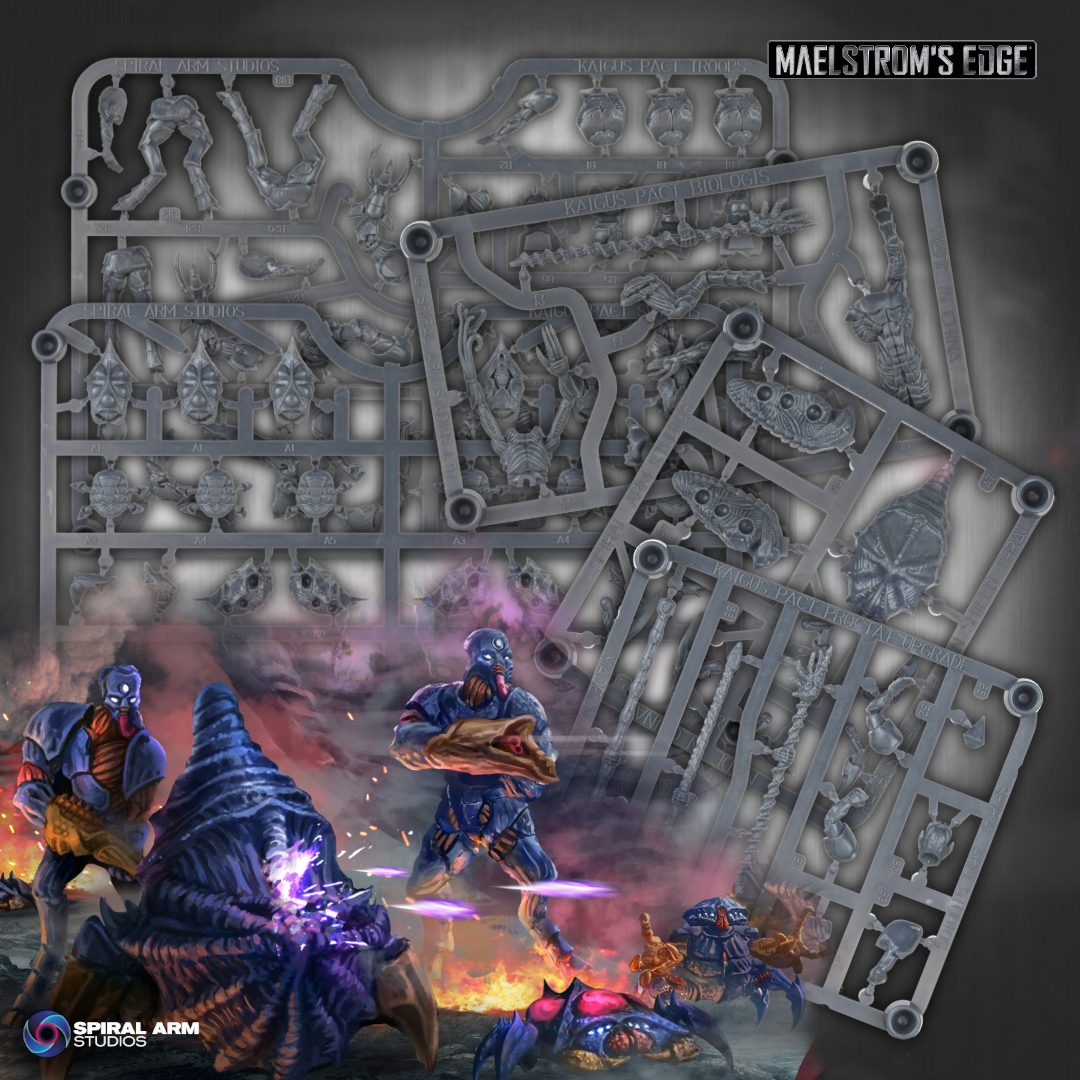
You can find five new plastic kits now available in the Maelstrom's Edge store, including:
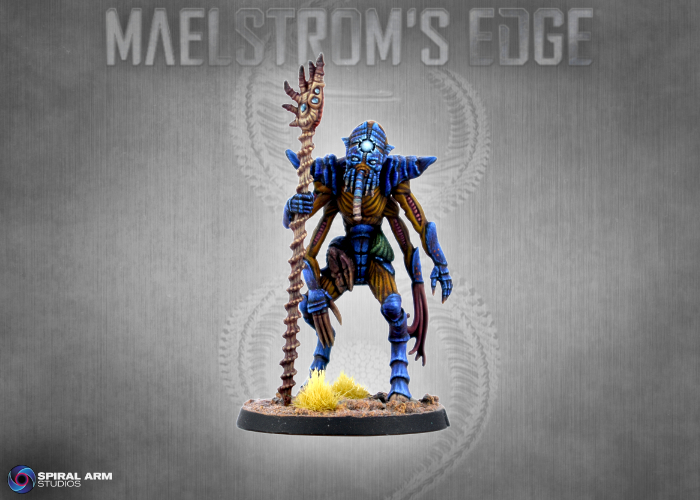
Biologis Curator- 1 Commander model.
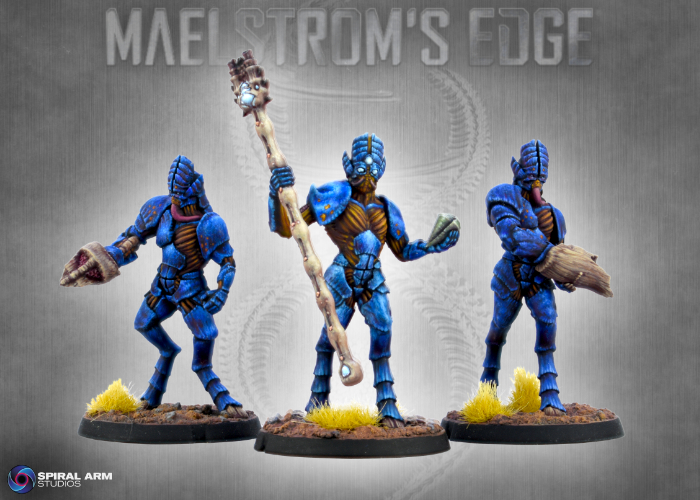
Biologis Attendants - 3 models along with the Proctat upgrade sprue.
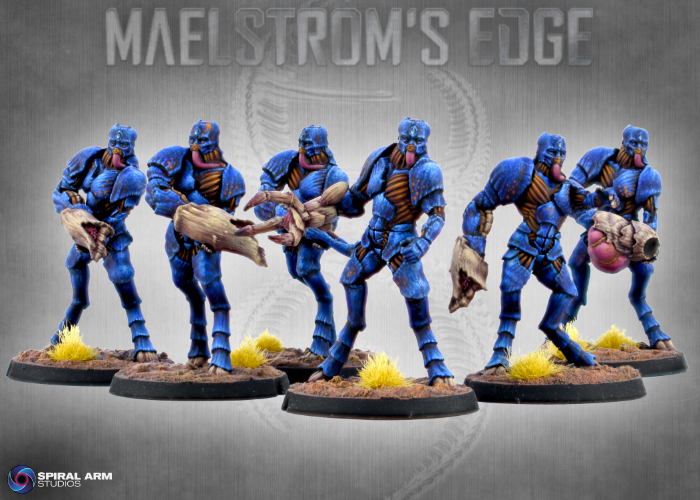
Kaigus Pact Troops - 6 models that can be built as either Muharis or Attendants.
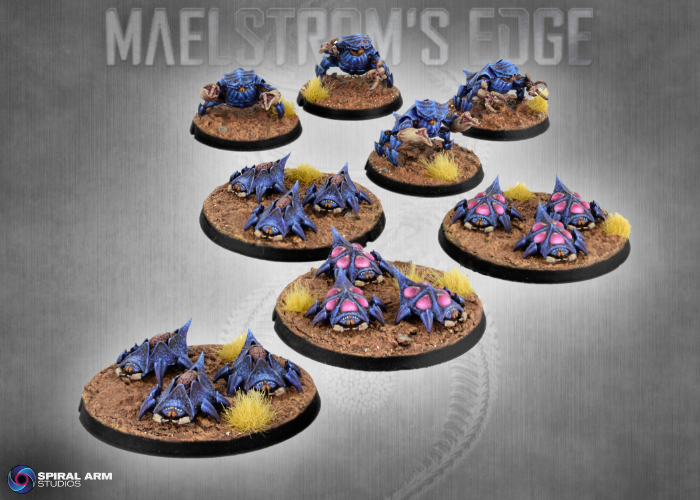
Kaigus Pact Thrall Swarm - building four Tamakin, and two each of Krii Vapor Thralls and Krii Shatter Thralls.
And the new arrival, as featured in the 'Enter, The Pact' battle report (which you can read here!):
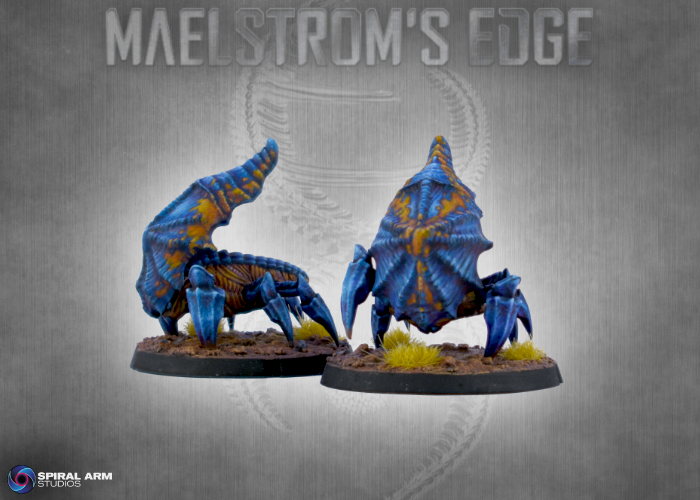
Orakan Shield Thralls - 2 thrall models.
Get the rules now!

The new V2 rulebook is available in the Maelstrom's Edge webstore now. You can also check out the V2 Rules Downloads section for PDF rules downloads, and the V2 Rules Articles section for some insights into the Maelstrom's Edge rules.
Stay Tuned for more!
Tags: curator kaigus krii muharis orakan pact tamakin thralls v2
Force Spotlight - 120 point Koritanii
Posted on Thursday Oct 30, 2025 at 06:54am in The Kaigus Pact
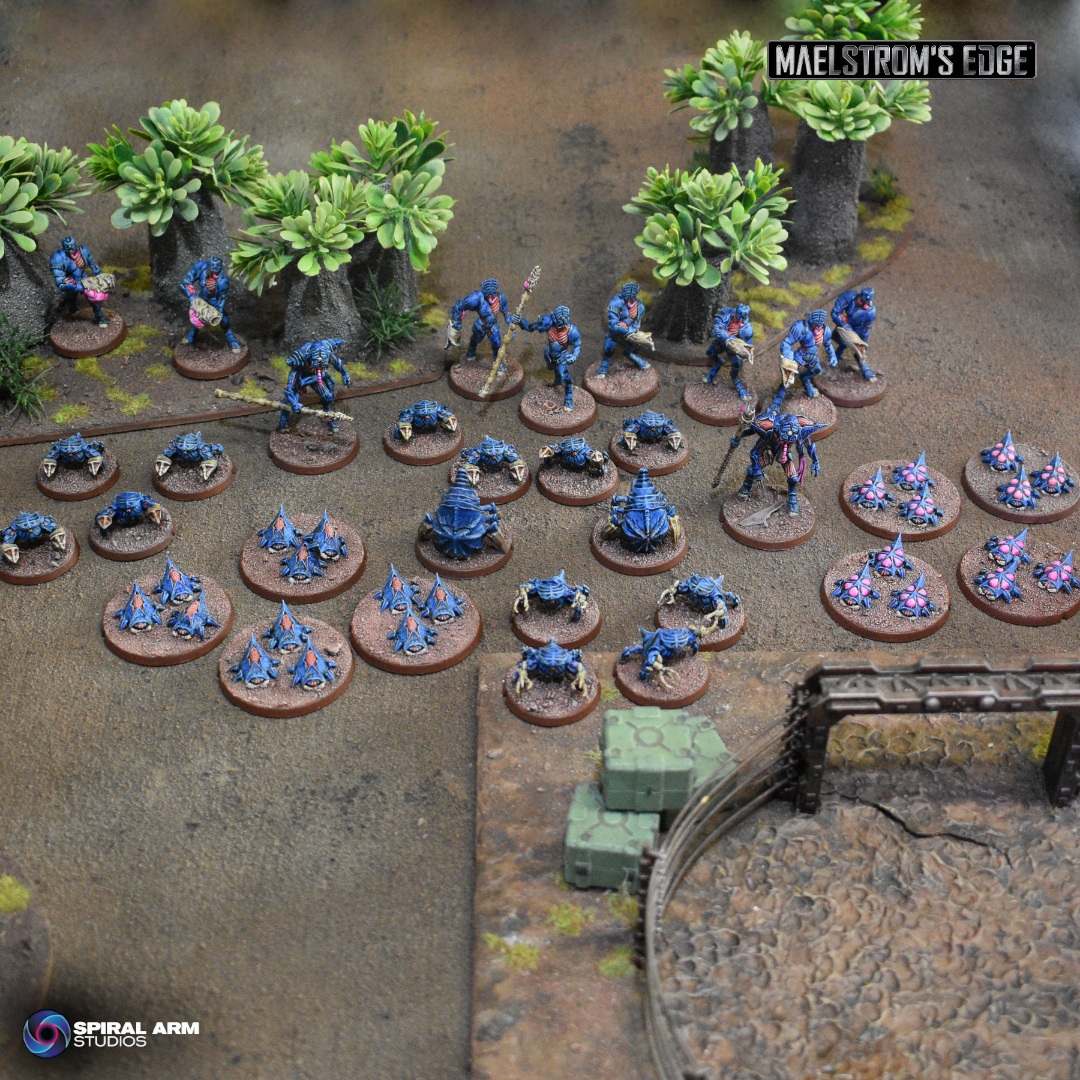
Model Spotlight - The Kaigus Pact Troops Sprue!
Posted on Wednesday Oct 15, 2025 at 05:00pm in The Kaigus Pact
 - by Iain Wilson
- by Iain Wilson
The arrival of the Maelstrom's Edge V2 rulebook was accompanied by the addition of an all new faction to the game - the Kaigus Pact! We're all very excited about them as the Kaigus Pact are very different to the other models we've released so far, with their alien appearance and organic approach to technology. This week, I thought I'd take a closer look at one of the new plastic kits - the Kaigus Pact Troops sprue.
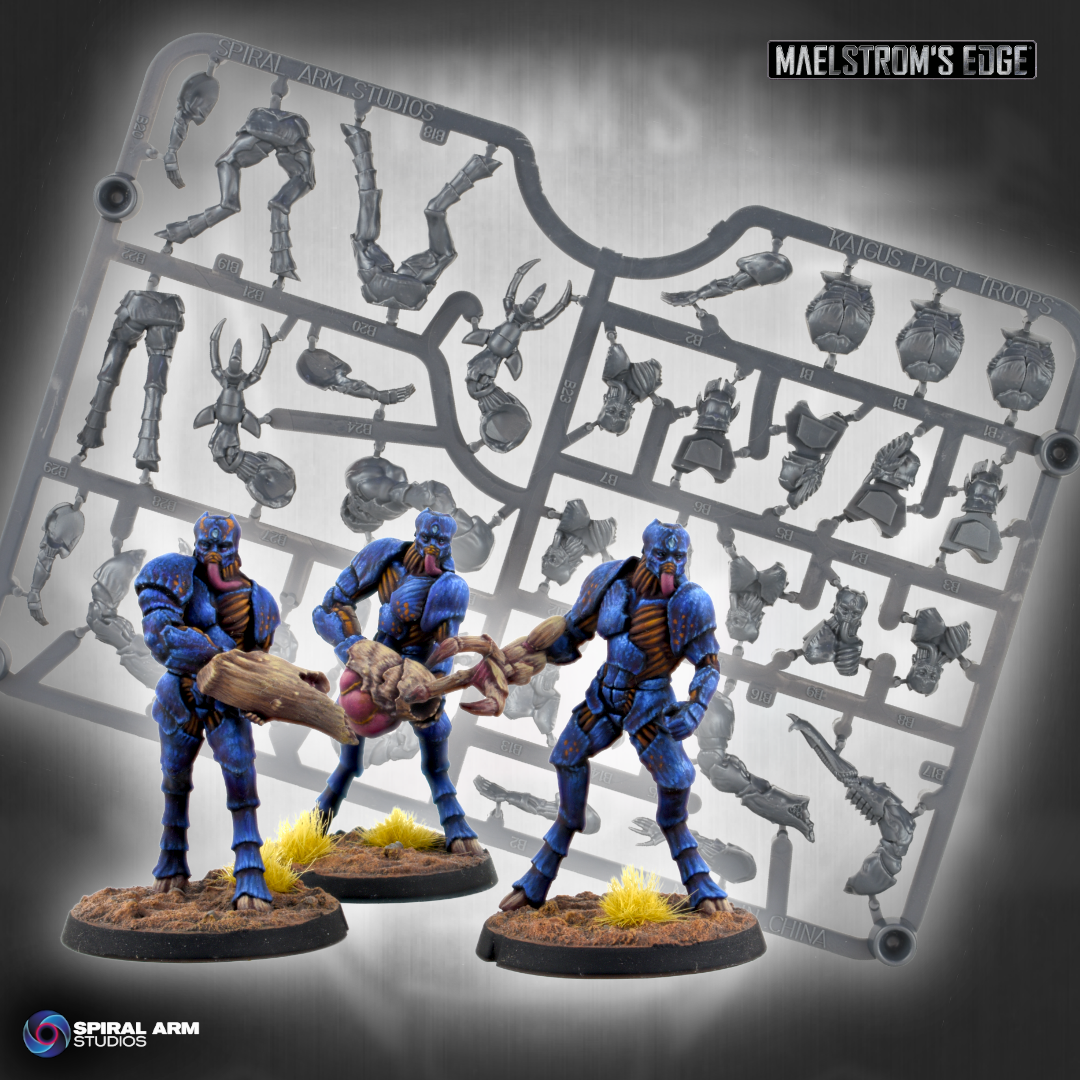
The troops sprue is one of a number of plastic sprues that we created for the Kaigus Pact launch, building three bioengineered warriors.
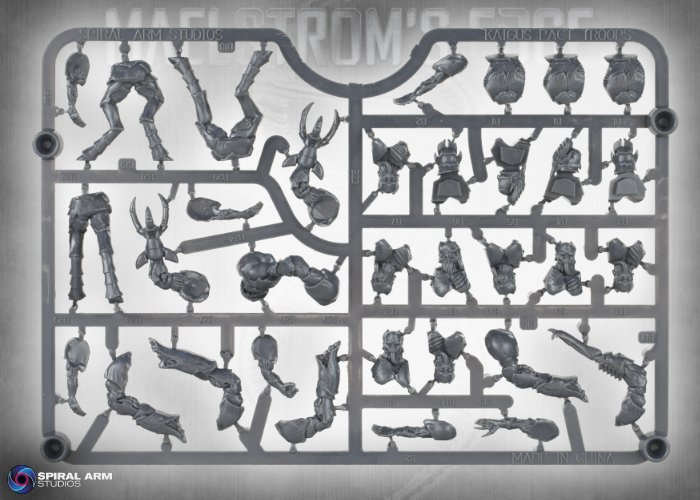
The Kaigus Pact Troops sprue, sculpted by Kevin Johnson.
Kaigus Pact soldiers, known as Muharis, generally take to the field armed with organic weapons called Dart Hosts. These are bioengineered crustacean-like organisms that clamp over the Muharis' weapon arm and, as their name suggests, spit lethal darts with the same force as a more normal firearm. More at home in space, the massive forms of the Muharis are gangly and awkward looking on the ground, their asymmetrical torsos and giant, carapace-clad forms a stark contrast from their human forbears.
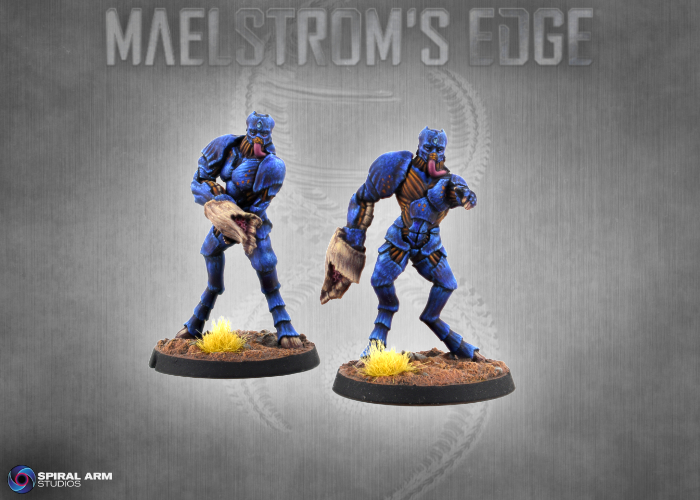
Kaigus Pact Muharis with Dart Hosts, painted by Todd McNeal.
Muharis have access to a number of other lethal weapon symbiotes, including a heavier version of the standard Dart Host, the armor-piercing Spike Rifle and explosive-lobbing Brood Host. When more close-range assaults are called for, Muharis make use of the giant taloned Ripper Claw.
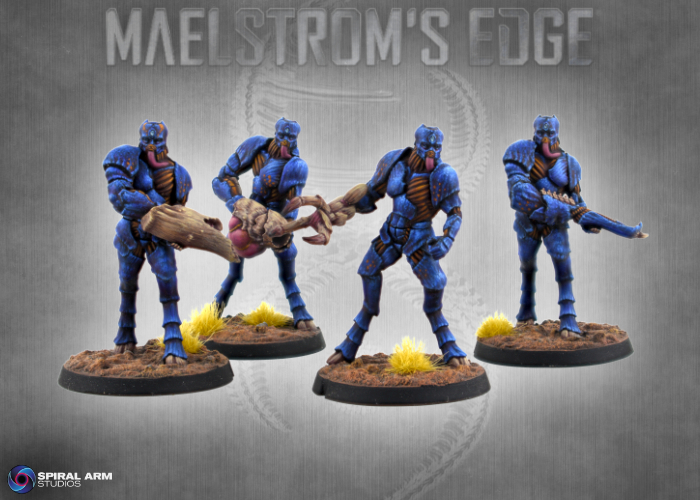
(Left to right) Heavy Dart Host, Brood Launcher, Ripper Claw & Spike Rifle, painted by Todd McNeal.
Regular Muharis Sentinel units have more limited access to these, while Sentinel Strongpoint units provide battlefield support with access to multiple heavier weapons.
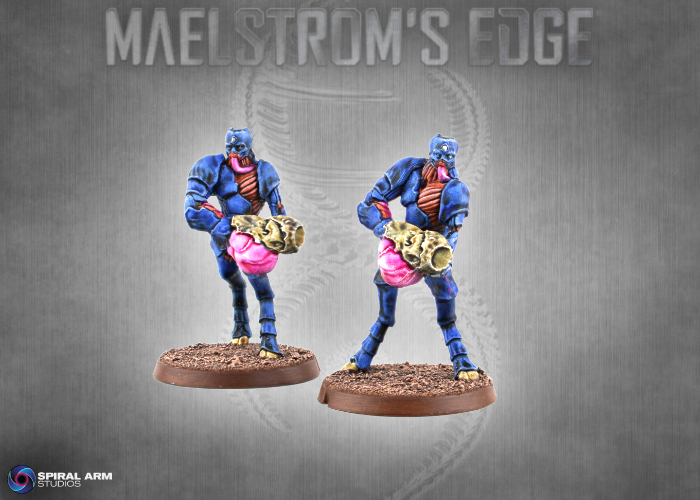
Sentinel Strongpoint unit with Brood Launchers, painted by Iain Wilson.
The troops sprue also allows you to build Biologis troops. more specialised than the Muharis soldiers, Biologis Attendants carry a shorter ranged but poisoned version of the Dart Host. The parts from the troops sprue can also be combined with the Proctat Upgrade sprue to build a Biologis Proctat, a Genostaff-equipped squad leader upgrade for Attendant units.
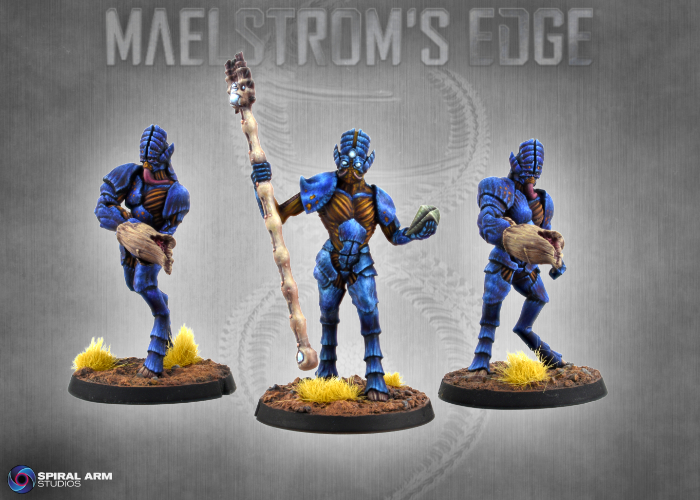
A Biologis Attendant unit, painted by Todd McNeal.
Biologis Adepts also serve as leaders in some Muharis Sentinel units, providing them the ability to spawn Thrall units on the battlefield.
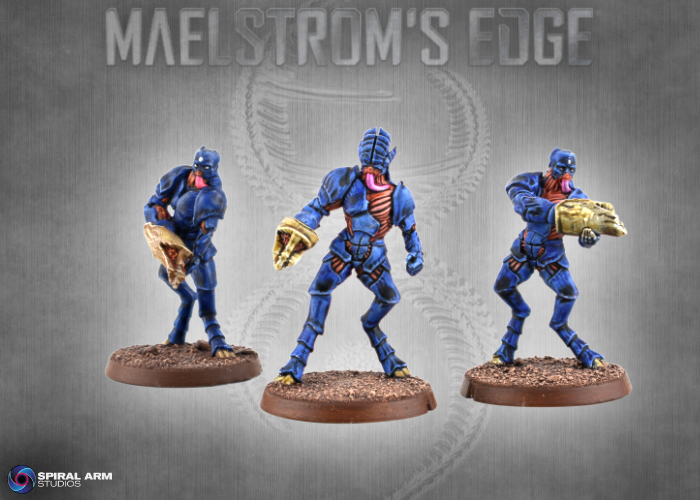
A Muharis Sentinel unit with attached Biologis Adept, painted by Iain Wilson.
Because of the unique design of their armour and equipment, the Kaigus Pact troops are not quite as modular as some of our other plastic kits. The most notable difference is in the heads, which we couldn't separate at the neck as we usually do. Instead, the sprue provides a number of different torso fronts, so you still get a wide range of posing options by combining different legs and torso fronts.
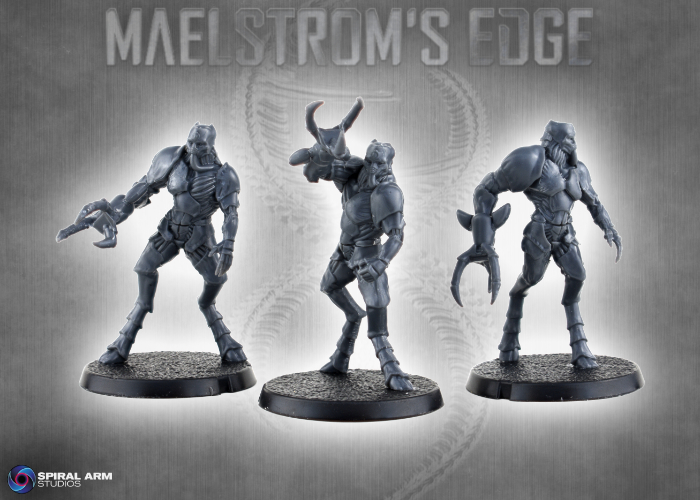
Muharis with Ripper Claws.
Being plastic, the models are of course easy to chop and change to suit yourself! While weapons are fixes to the arms, again due to their unique design structure and the limitations of plastic tooling, it's easy enough to slice weapons off and switch arms to give yourself some different posing options.
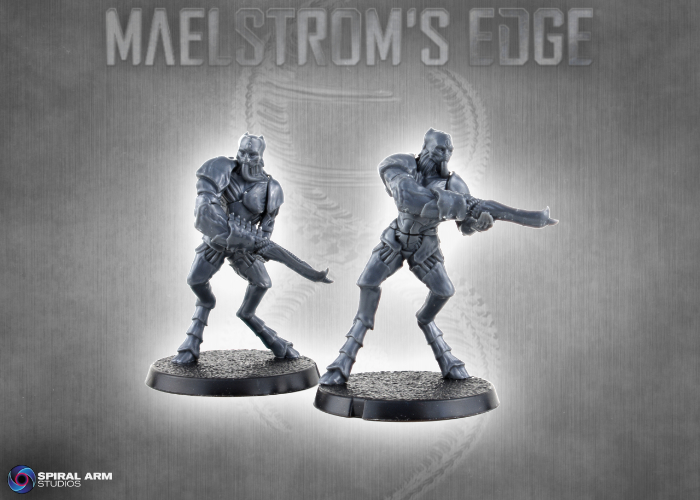
Muharis with Spike Rifles. the model on the left is the standard arm configuration, while the model on the right has had the weapon switched to a different arm, and a left arm from the Proctat Upgrade sprue.
And, of course, if you're like me and enjoy wandering outside the bounds of the 'official' game units, there's nothing stopping you from going to town with these kits and creating your own units!
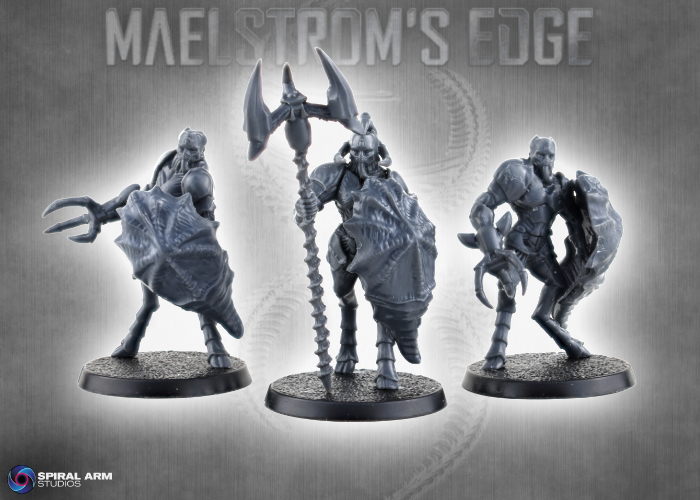
A unit I'm calling a 'Sentinel Spearhead', equipped with shields taken from the soon-to-be-released Orakan Shield Thrall, and a polearm made from a Proctat staff and Orakan legs!
The painted models shown here (both Todd's fantastic studio models and my more table-level versions) are representative of the Koritanii moot, found active in Zycanthus space. The Kaigus Pact models lend themselves to a wide range of organic color-schemes - we recommend looking to sea-dwelling crustaceans for inspiration!
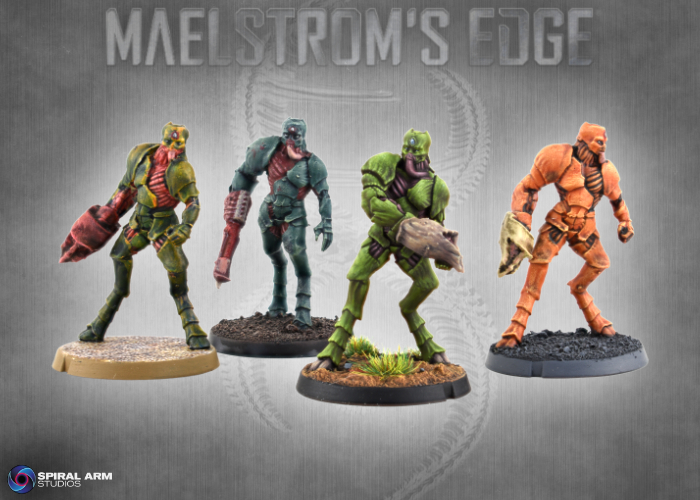
Some alternate Kaigus Pact color schemes.
The Kaigus Pact Troops box is available to buy soon, but in the meantime you can nab the sprue in the Kaigus Pact Starter Force box available now from the Maelstrom's Edge webstore here!
What are you working on? We would love to see your models and terrain in the Comm Guild Facebook group!
For other building ideas, modeling tutorials, army spotlights and conversion walkthroughs, check out the Hobby section of the Maelstrom's Edge website here. And while you're there, grab a copy of the Maelstrom's Edge V2 Beta rules!
Enter, The Pact - 120 point Battle Report
Posted on Tuesday Oct 07, 2025 at 05:00pm in Gaming
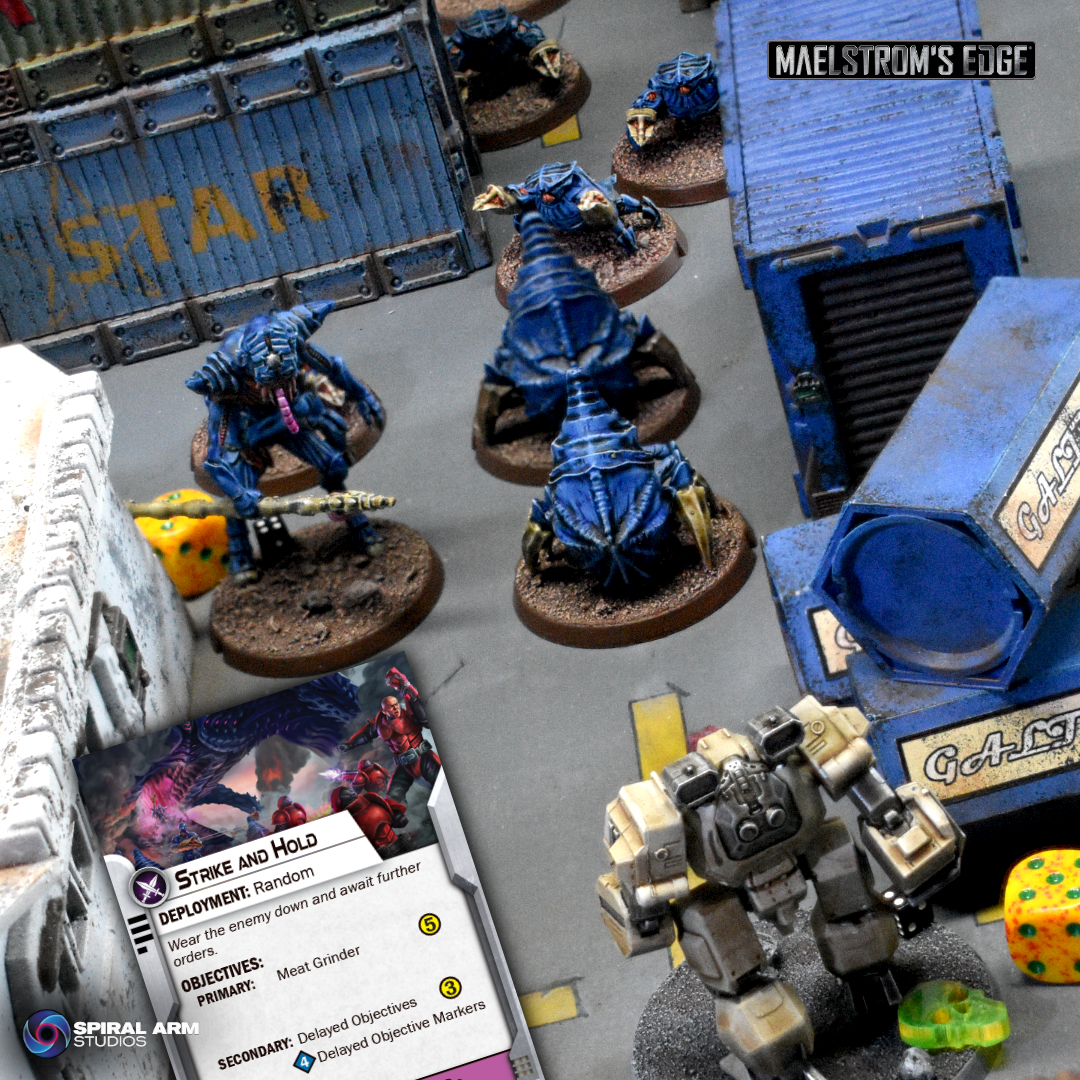
A new Maelstrom's Edge V2 battle report, featuring 120 points of Epirian Foundation militia taking on a Kaigus Pact assault in a Strike & Hold mission! Check it out here!
The Kaigus Pact arrive on the battlefields of the Edge!
Posted on Monday Sept 29, 2025 at 05:00pm in The Kaigus Pact
And now, you can bring these bioengineered forces to your own tabletop, with the release of the Kaigus Pact Starter Force for Maelstrom's Edge V2!
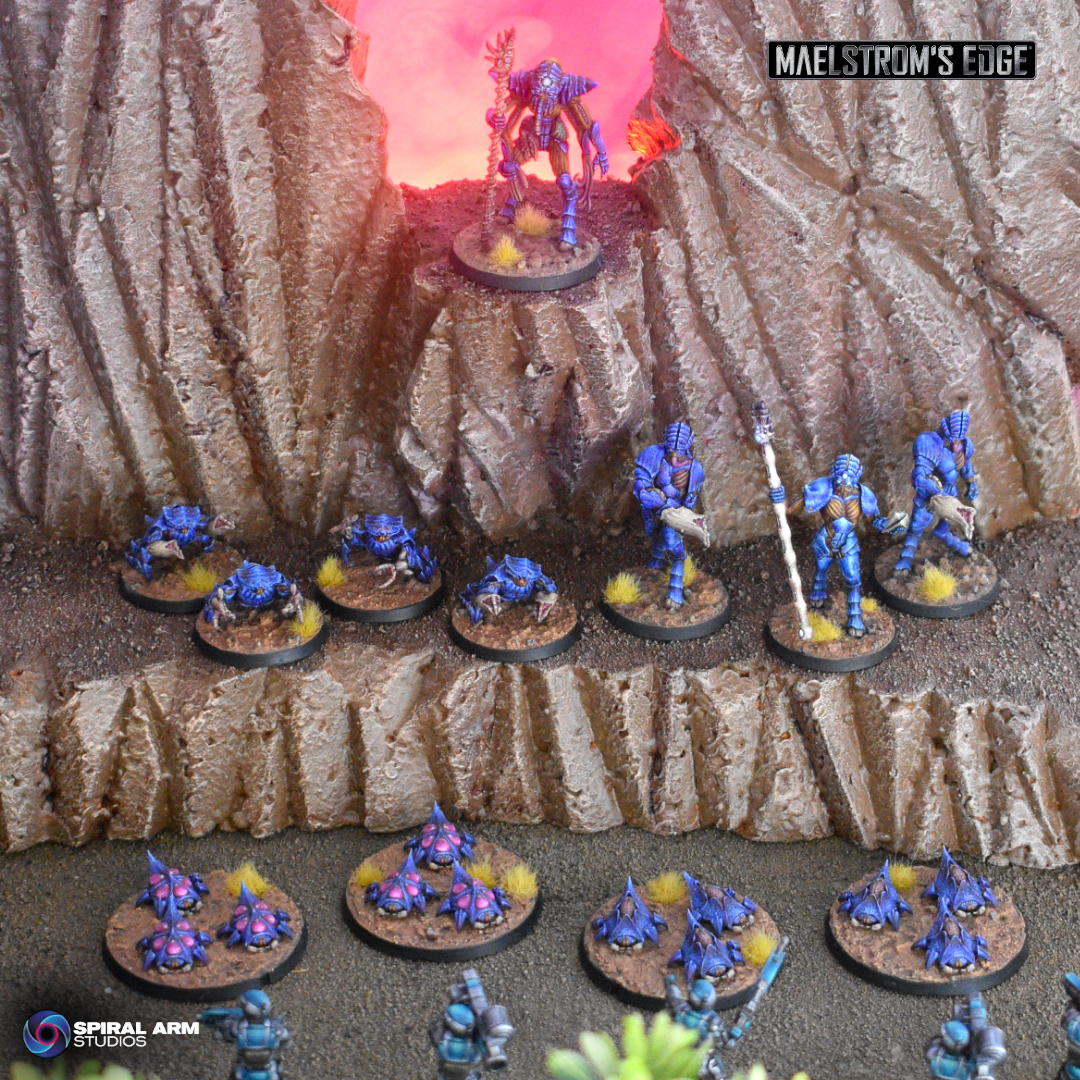
This collection of Kaigus Pact models builds around 50 points, forming a solid foundation to expand into a full force. Included are the following plastic Kaigus Pact sprues:
- 1 x Kaigus Pact Biologis Curator with a 36mm base.
- 1 x Kaigus Pact Troops Sprue, building up to 3 models with 32mm bases.
- 1 x Kaigus Pact Proctat Upgrade Sprue, which combines with the Troops sprue to upgrade a unit leader.
- 2 x Kaigus Pact Thrall Sprues, which build 4 x Tamakin, 2 x Krii Vapor Thralls and 2 x Krii Shatter Thralls, with 32mm and 46mm bases.

Biologis Curator, painted by Todd McNeal.

Biologis Attendants, painted by Todd McNeal.

Tamakin and Krii (Thralls), painted by Todd McNeal.
To find out more about the Kaigus Pact, check out the Faction Focus article here and the Colors of the Kaigus Pact article here. Or, of course, pick up the shiny new V2 rulebook!
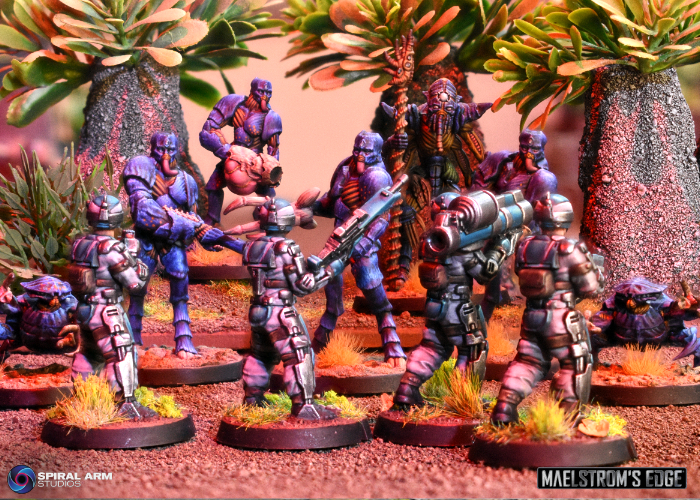
SecDef try in vain to hold off a Kaigus Pact assault.
Get the rules now!

The new V2 rulebook is available in the Maelstrom's Edge webstore now. You can also check out the V2 Rules Downloads section for PDF rules downloads, and the V2 Rules Articles section for some insights into the Maelstrom's Edge rules. The website also includes a handy Force Builder which allows you to easily build and save your force lists!
Stay Tuned for more!
Maelstrom's Edge V2 Rules PDFs!
Posted on Friday Sept 26, 2025 at 05:00pm in Gaming
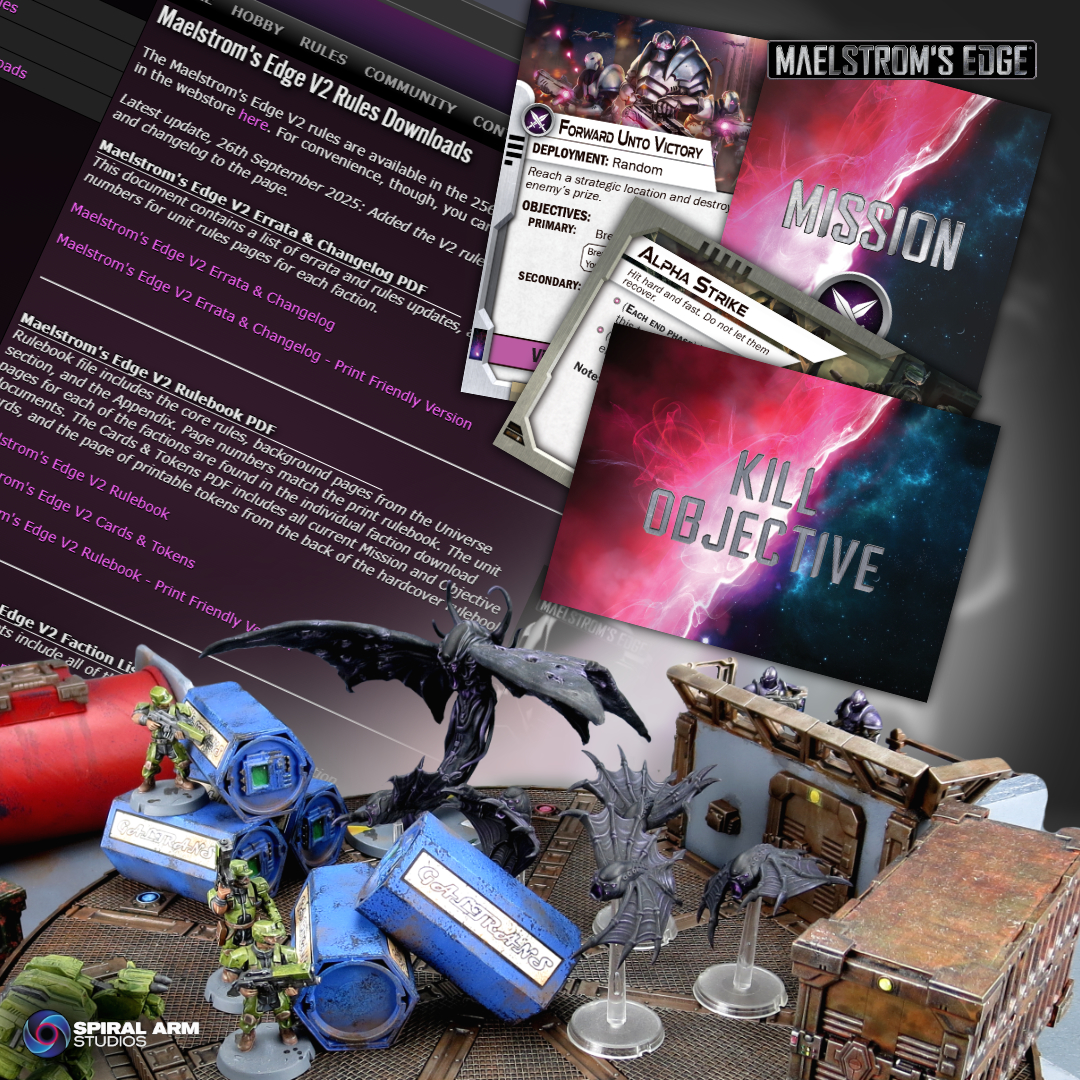
The downloads include a PDf version of the rulebook, which has the core rules, the background bits from the Universe section, and the additional rules from the Appendix. There is an Errata & Changelog document, which lists any changes we need to make to the rules. This currently includes a couple of small corrections to errors we've spotted in the print book, which have been incorporated into the PDF version of the rules. This document also has a list of the version numbers of all of the current unit entries. The unit rules entry pages have been split out into separate documents for each faction, so you can grab and print the ones you need for your force. This also gives us the ability to update individual units if that becomes necessary, and also means we can add in new units by including them in these downloads.
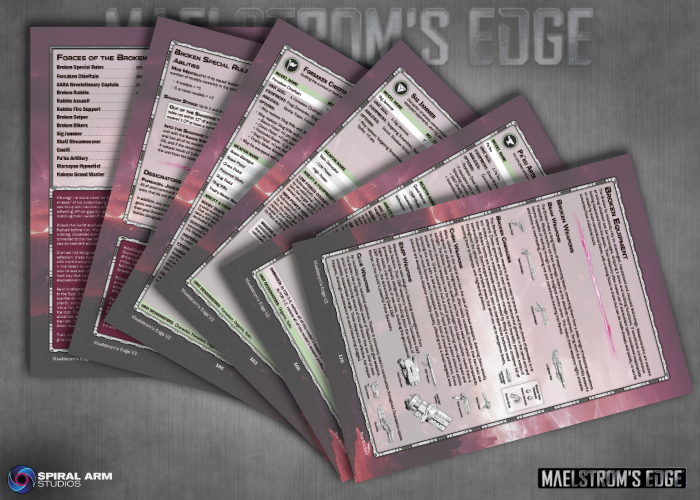
You can also find a 'Cards & Tokens' document, which includes printable versions of all missions and objectives, and also the page of tokens from the back of the rulebook - later on, we'll also be releasing some 3D printable versions of the tokens, and we're looking at a print-on-demand option for the cards.
You can find all of these documents in the Rules section of the Maelstrom's Edge website here. While you're there, grab your copy of the rulebook from the webstore!
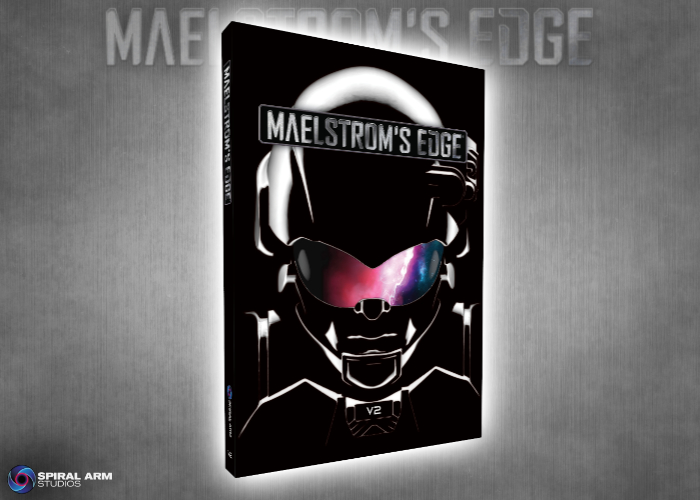
If you have any thoughts on the new rules, pop on over to the Comm Guild Facebook group, or start up a thread in the Maelstrom's Edge section on the Dakka Dakka forums. We welcome any feedback, and would love to hear how everyone's forces stack up in the new rules!
Maelstrom's Edge V2 - Terrain
Posted on Wednesday Sept 24, 2025 at 05:00pm in Gaming
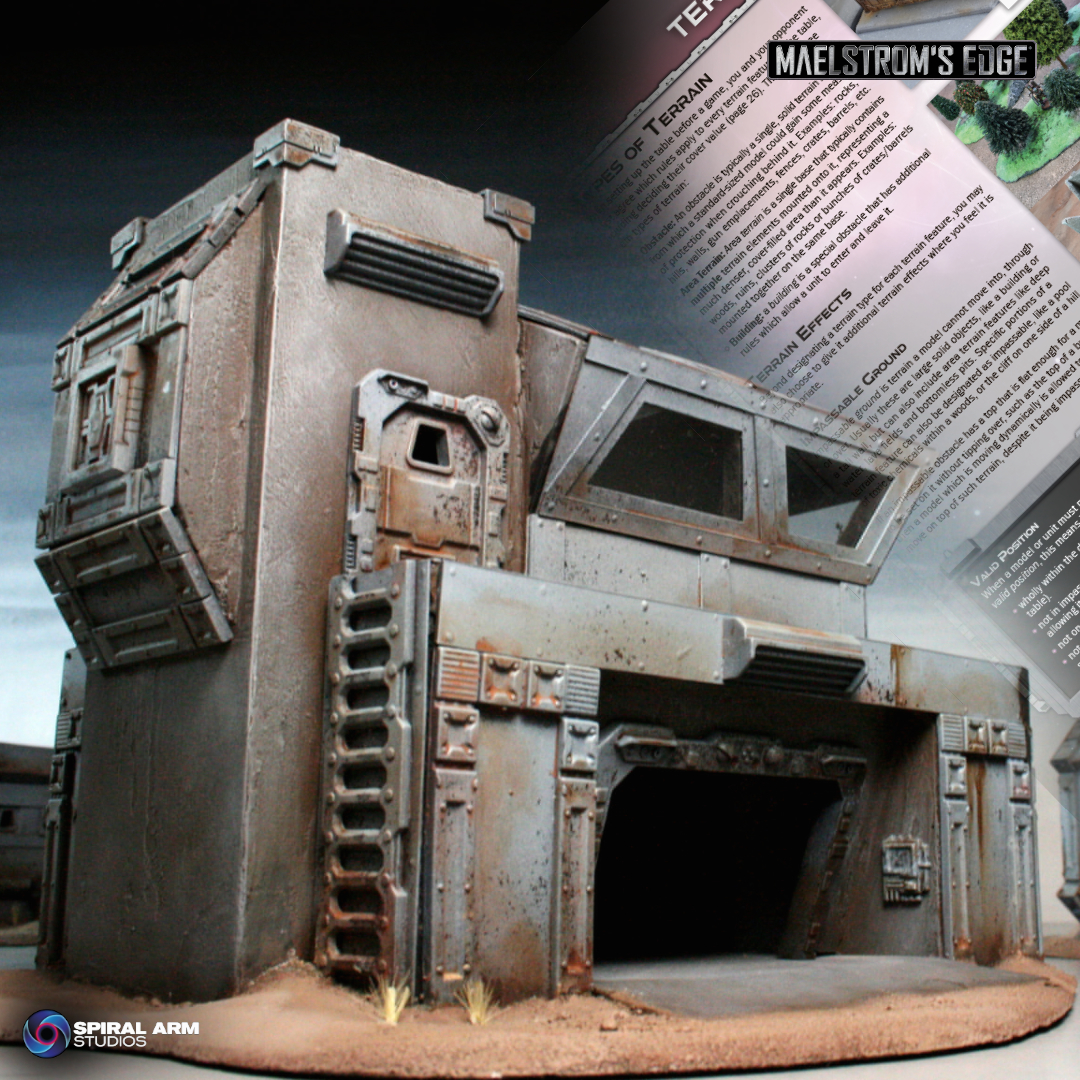
There are three main types of terrain:
- Obstacle: An obstacle is typically a single, solid terrain feature from which a standard-sized model could gain some measure of protection when crouching behind it. Examples: rocks, hills, walls, gun emplacements, fences, crates, barrels, etc.
- Area Terrain: Area terrain is a single base that typically contains multiple terrain elements mounted onto it, representing a much denser, cover-filled area than it appears. Examples: woods, ruins, clusters of rocks or bunches of crates/barrels mounted together on the same base.
- Building: a building is a special obstacle that has additional rules which allow a unit to enter and leave it.
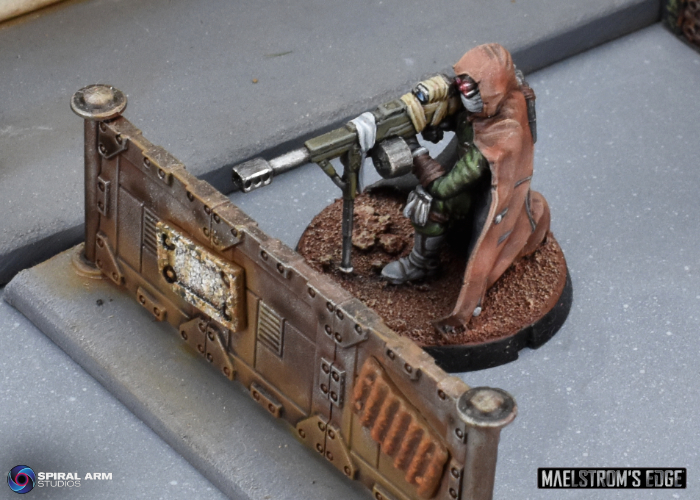
You may also choose to give terrain features additional terrain effects where you feel it is appropriate.
- Impassable ground: terrain a model cannot move into, through or over. Usually these are large solid objects, like a building or a tall wall, but can also include area terrain features like deep water, lava fields and bottomless pits. Specific portions of a terrain feature can also be designated as impassable, like a pool of toxic chemicals within a woods, or the cliff on one side of a hill.
- Dangerous ground: terrain that causes minor damage to units moving through it. Instead of deciding that a river of lava, minefield, cliff, etc., is impassable, you may opt to instead make it dangerous ground, raising a unit's suppression level when they move through it. (For more on suppression, see the article here!
- Open ground: parts of the battlefield that don’t contain any terrain features, or any portion of a terrain feature you feel shouldn’t protect a unit that takes cover there, like the flat top of a platform.
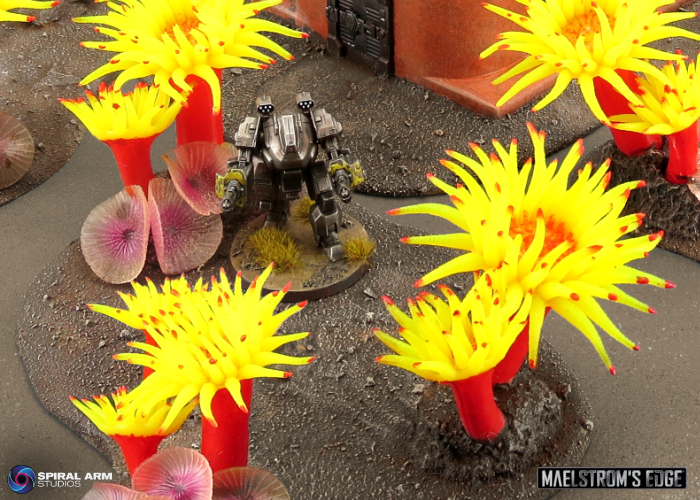
Moving through terrain generally doesn't affect how far a unit can move, although vertical movement over 2" (moving up a multi-level ruin, for example) is counted towards the distance travelled. Beyond that, we didn't want terrain to complicate movement any more than it needs to, as troops moving on a battlefield are already moving with care - a few trees shouldn't force them to slow down that much!
Terrain does affect line of sight, however! Obstacles block line of sight exactly as they appear on the table: if you are able to spot an enemy model through or over an obstacle, then your unit has line of sight to them. Area terrain, however, represents a much denser grouping of terrain than is actually seen on the tabletop. Therefore, line of sight can be drawn to models in the area terrain, but can't be drawn from outside an area terrain feature and pass entirely through it to see models on the other side.
Models are assumed to be making use of available cover as they move around the battlefield. As such, the normal shooting rules don't confer any bonus protection to a unit that is partially obscured by default. Instead, shooting units receive a bonus to their shooting if the target is completely in the open. Conversely, a unit that is touching an obstacle or in area terrain can receive a bonus defense from terrain through the 'Take Cover' status action. For more on unit activation, check out the article here!
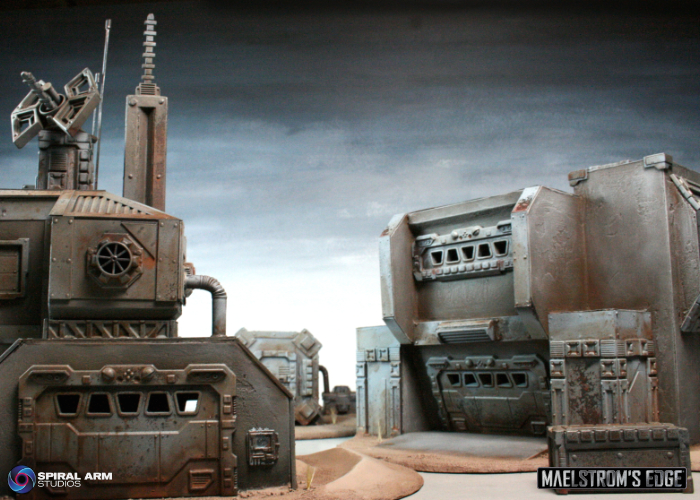
You can find the full terrain rules in the Maelstrom's Edge V2 rulebook. Grab your copy from the Maelstrom's Edge webstore now! And while you're there, you can pick up the Maelstrom's Edge terrain sprues - packed full of plastic details to add to your scratchbuilt terrain!

If you have any thoughts on the new rules, pop on over to the Comm Guild Facebook group, or start up a thread in the Maelstrom's Edge section on the Dakka Dakka forums. We welcome any feedback, and would love to hear how everyone's forces stack up in the new rules!
Faction Focus - The Epirian Foundation
Posted on Monday Sept 22, 2025 at 05:00pm in The Epirian Foundation
In battle, the Foundation’s greatest strength comes from their advanced robotics technology, boosted via neural links to trained Handlers. Fast, scouting Firefly drones and battle lines of Spider Drones are backed up by heavier-armed Scarecrows and Hunter Warmechs. Alongside this army of artificial combatants are human Contractors, employees of the Foundation who function as mechanics, workers and militia, depending on the situation, while the elite forces of SecDef can be called in when the situation calls for more experienced troops.
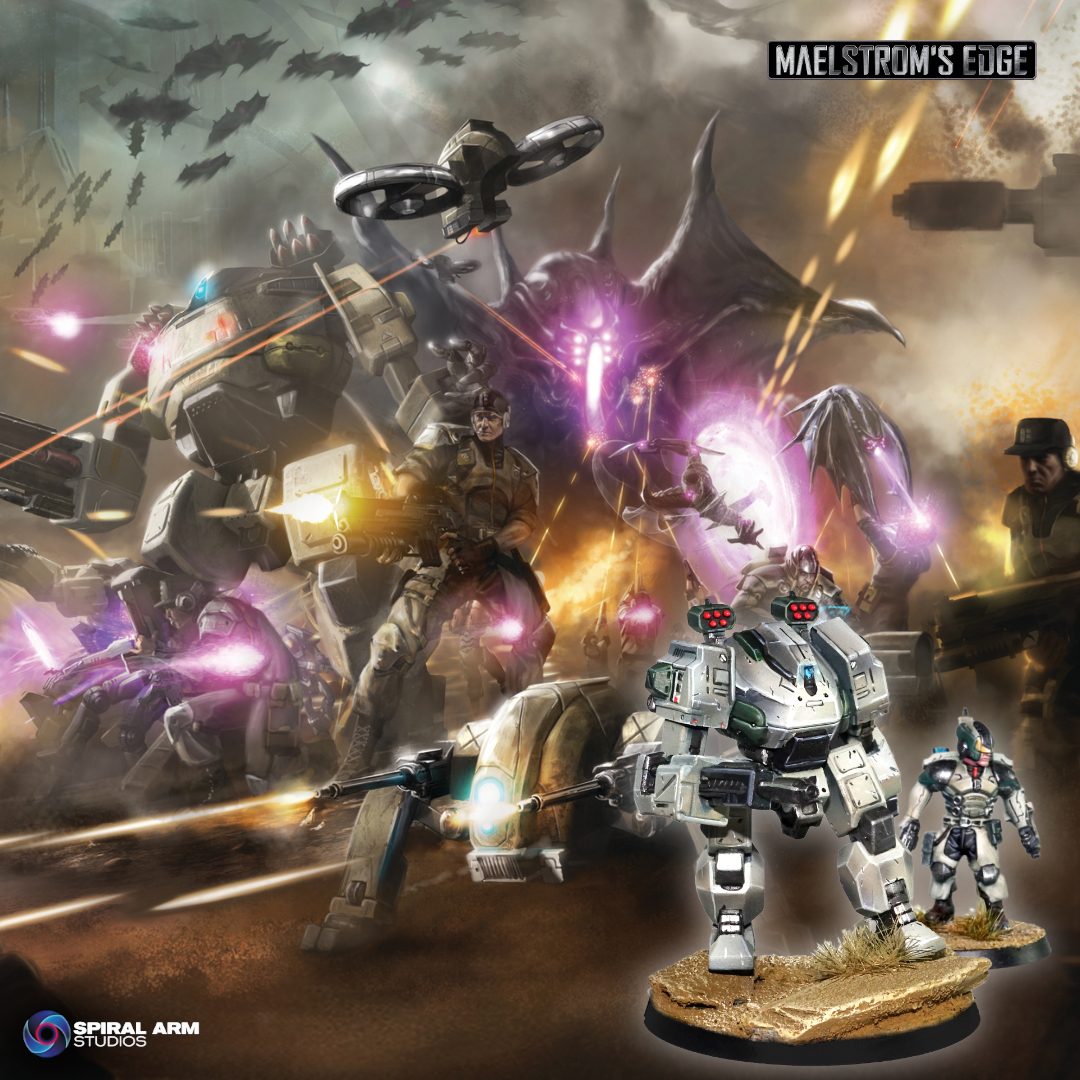
Neural linking was developed as a means to increase and expand a robot’s actions and capabilities with creativity and intuition. Bot Handlers, through a neural web embedded in their helmets and years of rigorous training, can channel a portion of their awareness into properly configured bots. This process is referred to as projection. The Bot Handler gains a degree of control over the bot, be it a drone, a mech or a starship. This may be as simple as overriding a set of responses to allow for an unpredictable deviation from programming to surprise an enemy, or, in some cases if the Handler is expert enough, direct piloting of one or even several robotic constructs.
The weapons used by the Foundation tend to reflect the rugged nature of the terraforming outposts. Energy and plasma weapons are deemed risky endeavors, requiring too much maintenance and yielding unpredictable results. Epirian robots and soldiers tend to be outfitted with hard-bullet weapons, as well as computer controlled missiles and the occasional converted industrial tool – mining lasers, blasting explosives, railguns and the brute force of robotic drills and saws.
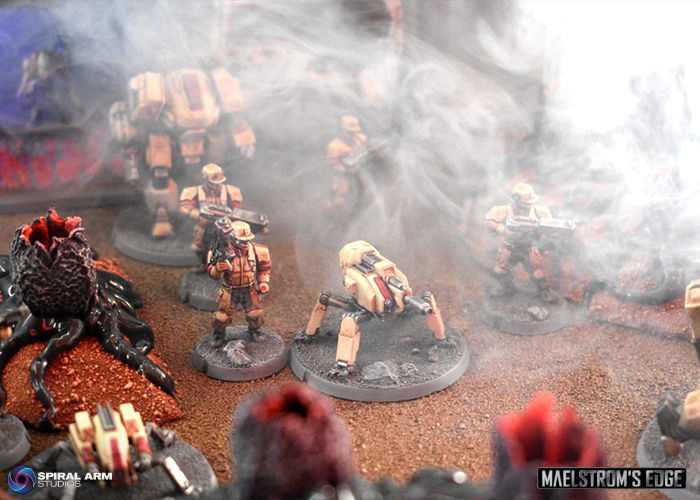
Before the Maelstrom, SecDef acted as the enforcement arm of the overarching Foundation corporate structure — A hand-picked selection of the most decorated Epirian soldiers, acting outside the purview of any one franchise. With their need for independence and operational security, SecDef traditionally eschew the use of robots, to avoid the potential for a franchise to subvert their operations with back door code or production issues.
With the splintering of the Foundation, many SecDef units have come under more direct control of various individual franchises or multi-system Epirian hubs attempting to reestablish central leadership. Billed by their corporate owners as the ultimate in precision combat, SecDef are hired out to wealthy companies and individuals across the galaxy, serving as military escorts, bodyguards, or even leading attacks on rival corporations or hostile alien worlds.
SecDef’s preferred weaponry and equipment is traditionally manufactured by Araldyne, one of the last great Epirian weapon franchises. Their weapons are both more advanced and significantly more expensive than those produced by the rest of the Foundation, prioritizing sleek design and optimized technologies over the cheaper, mass-produced products used by lesser troops.
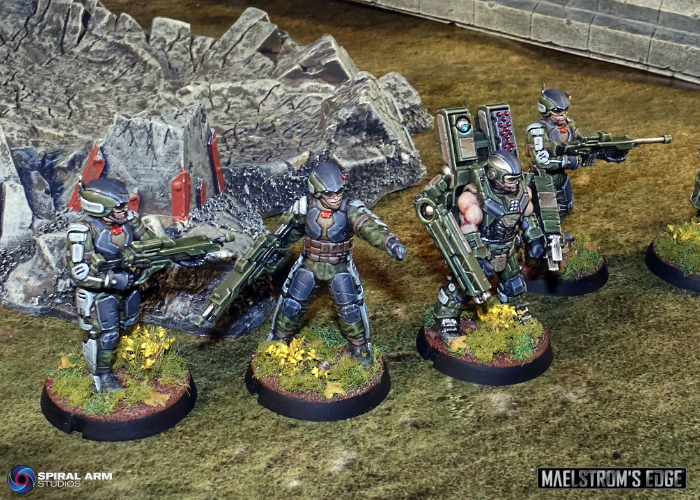
On the table, the Epirian Foundation's main strength is in the synergy between bots and their handlers. Bot Protocol abilities allow a handler to spend command points to boost the effectiveness of their charges, making them move faster, increasing their rate of fire, or improving their ability to make use of available cover. Combining these with careful choice of activation order allows a canny commander to get extra usage out of their bots - reactivating a unit for a second attack, or using multiple bot units to back each other up - speedy Fireflies Painting a target with their lasers for follow-up by Hunter Warmechs with their Guided Strike missiles, for example.
SecDef Field Commanders carry almost as much firepower in their armored exosuits as a Hunter Warmech, and grant their forces the ability to hold objectives even with enemy units nearby. SecDef infantry can capitalize on this, using Aerial Insertion to drop directly onto their objective and Cover Drill to let them dig into available cover while holding off enemies with their advanced Araldyne weaponry, while boostpack-equipped Rapid Insertion Teams can jump rapidly across the battlefield providing supporting fire where it is most needed.
Find out more about the Epirian Foundation on the Maelstrom's Edge website here.
The Maelstrom's Edge V2 rulebook is now available! Grab your copy from the Maelstrom's Edge webstore now!

If you have any thoughts on the new rules, pop on over to the Comm Guild Facebook group, or start up a thread in the Maelstrom's Edge section on the Dakka Dakka forums. We welcome any feedback, and would love to hear how everyone's forces stack up in the new rules!
Colors of the Kaigus Pact
Posted on Friday Sept 19, 2025 at 05:00pm in The Kaigus Pact

Click for larger image
The Kaigus Pact will be coming to the Maelstrom's Edge webstore soon with a range of new plastic kits. Stay tuned for news!
Maelstrom's Edge V2 - So, what's changed?
Posted on Thursday Sept 18, 2025 at 05:00pm in Gaming
If you’re a big fan of the V1 rules, then you’ll be pleased to know that the core pillars that comprise Maelstrom’s Edge are not only still there, but have been strengthened. It’s still an alternating activation, squad-based “skirmish” game (aka focused on small squads of 1-6 models) that features 6-sided dice (D6), multi-tiered mission objectives, a suppression mechanic, the ability to bring back destroyed units as reinforcements and a regenerating command point system that can be used for a variety of tactical functions.
If, on the other hand, you’re someone that liked the overall concept of the original Maelstrom’s Edge rules, but you thought that the rules were a little too fiddly, then we also have great news for you! The v2 rules have been totally re-written and highly streamlined: they are a good 30% shorter than the V1 rules as a result. While the V2 rules are undeniably simpler, they’ve also gotten more complex where it counts: giving you tons of new tactical decisions to make with your units during the game. On top of that, the dice rolling “engine” now feels really fresh: each round of shooting keeps both players involved rolling dice and utilizes a “dice flip” mechanic that adds an element of bad luck protection right into the core of the game.
Below, we'll run through some highlights of the major v2 changes. (If you're a player of the V2 Beta rules, and just want to know what's changed in the final rulebook version, skip to the end of the article. Or, you know, read it anyway - we worked hard on it!)
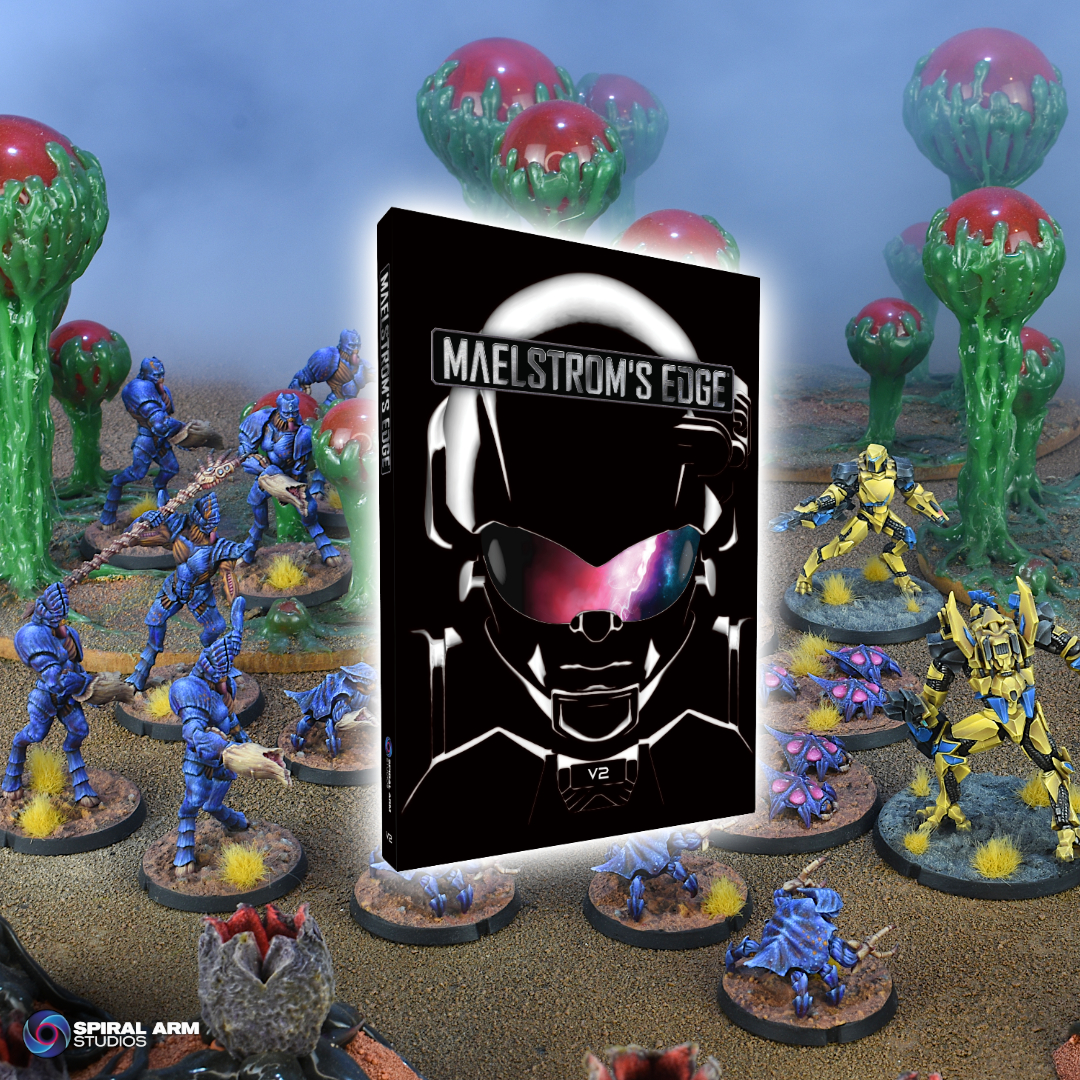
SIMPLIFIED UNIT ACTIONS
The largest change in V2 is how unit actions work. The activation test is gone and a unit can now perform up to 3 actions, selected from: movement actions (Move, Dash, Charge), status actions (Aim, On the Move, Take Cover) and shooting actions (Fire, Suppressive Fire, CQ Fighting). While there are some additional caveats to this system (a unit can perform a maximum of only 1 movement and 1 shooting action per activation, for example), we’ve found during playtesting that by splitting the action rules into these smaller “bite-sized” chunks, it makes the whole system much easier to remember. In addition, decoupling movement, shooting and status rules from each other now gives players several new combinations of what to do with their units when they activate them. You can find out more on how this all works in our Unit Activation article here.
SUPPRESSION THAT MATTERS
In V2, suppression is both much simplified and also a whole heck of a lot more deadly. Instead of utilizing tons of suppression tokens, each unit only has 6 suppression levels (which can be conveniently tracked with a D6 next to the unit). Not only does suppression still degrade a unit’s shooting and their ability to benefit from cover, but each time a unit already at max suppression is called upon to raise their suppression level again, one model in the unit instead suffers an injury (which is fatal for most standard infantry in the game). This means it is now entirely possible to ”suppress” an enemy unit to death, representing them fleeing from the battlefield due to the hail of firepower coming their way. This makes the new Suppressive Fire action (which trades-in a shooting unit’s ability to cause damage for a boosted ability to cause suppression) a deadly tool in certain situations. Find out more int he Suppression article here.
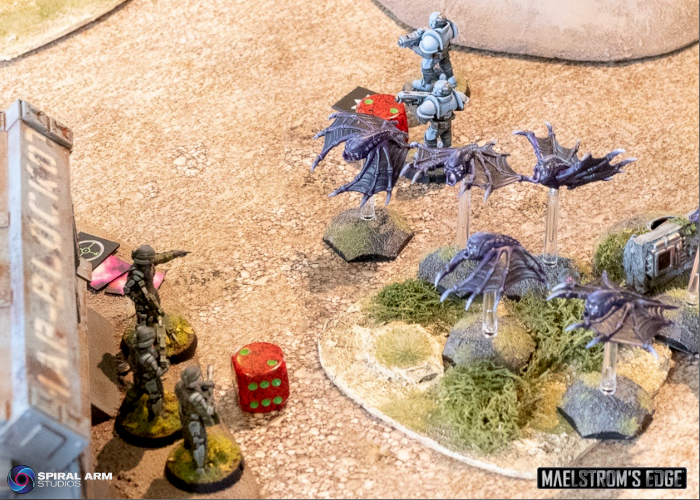
A NEW DICE ENGINE
The new dice rolling engine in v2 is quite unique, but still based exclusively on 6-sided dice that most players prefer. It is both simple enough to quickly understand, yet nuanced enough to offer: built-in bad luck protection, having both players involved with each round of shooting and tactical player choice within the dice rolling process. Most importantly, when units shoot at each other, the amount of damage they cause now just feels right.
So how does the new system work? As a firing player, all you have to do is look to equal or beat the target’s Evasion characteristic (EVS) with your D6 rolls. For example, if the target has an EVS 4 (the standard EVS of most infantry units), you’d need results of 4-6 to successfully hit them. In addition, as the firing player you get to influence these results by making a number of “dice flips” (changing the result of rolls in your favor) up to the Skill characteristic (SKL) of your firing unit. For example, if your firing unit was SKL 3, you could add +3 to a single roll, +1 to 3 different rolls, or anywhere else in between. Where things really get interesting is that results of ‘1’ and ‘6’ are “critical” results. A “critical hit” (a hit roll result of ‘6’) provides that shot with extra lethality. But it also takes 2 dice flips to change a non-critical result into a critical result (a ‘5’ result into a ‘6’). This means sometimes you have to decide whether using 2 dice flips to change a single ‘5’ result into a critical hit will be more beneficial than just using those same dice flips to score two more standard hits.
And of course, once the firing player has determined how many hits they’ve scored on the target, the defending player gets to make an armor roll against each hit, looking to equal or exceed the Penetration characteristic (PEN) of the firing weapon. Similarly, the defending player gets to influence the results of these rolls with a number of dice flips equal to the Armor characteristic (AV) of their models. Find out more in our Shooting Modes article here
FEWER SPECIAL RULES
With V2, we’ve realized that adding back a few more characteristics to the model/weapon profile means a big reduction in the amount of special abilities in the game. Plus, the abilities we have kept have been greatly simplified, all with the end goal of making each unit’s full rules (including all the text for their unit and weapon abilities) fit onto just a single page.
Here’s a quick rundown of the “new” model & weapon characteristics in V2:
- The model profile has lost its Mass characteristic (MAS), but has gained the Close Quarters Attacks characteristic (CQA) instead, rectifying the biggest point of negative feedback we got about the V1 rules: the much maligned ‘formula’ that was necessary to determine how many melee shots a model was able to make.
- The weapon profile has gained a Suppression characteristic (SUP), which is utilized when the unit makes a Suppressive Fire action.
- The weapon profile has gained a Weapon Type characteristic (TYPE), which helps set apart the archetypal weapon rules (like “AoE”, “Heavy” or “Short Ranged”) from true weapon special abilities.
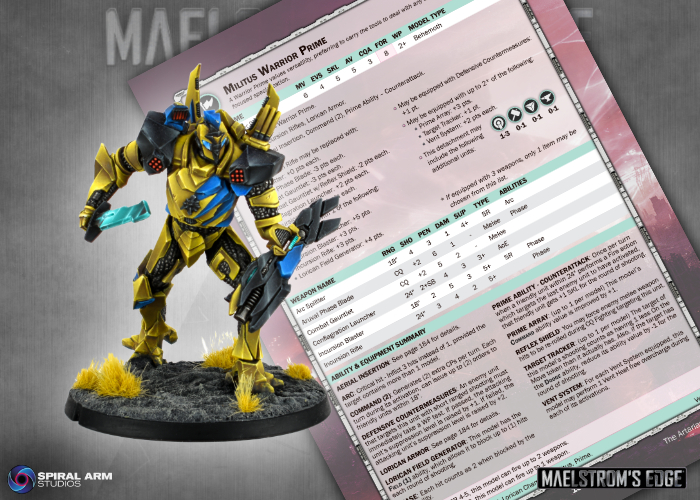
MORE LETHALITY
One goal of the V2 rules has been to improve the level of lethality in the game. Allowing massive amounts of suppression to inflict damage to a unit was a good first step, but the real key to this change has been the removal of the Mass characteristic (MAS) from the model profile. Now, each point of damage a model suffers just reduces their Fortitude (FOR) characteristic by 1 (and when a model reaches 0 FOR, it is a casualty). The vast majority of standard infantry models only have FOR 1, which means that any hit which gets through their armor will cause a casualty. While this doesn’t suddenly mean that models are now dying in droves in V2, we can safely say that you will notice and appreciate the increase in lethality in the game. You’ll definitely want to start using the reinforcement rules more often to bring back your destroyed units!
QUALITY OF LIFE IMPROVEMENTS
The V2 rules are chock full of little improvements that make the game feel way better overall. Here’s a taste of them:
- Command points no longer need to be allocated to command models. They just stay in your command point pool until you decide to use them.
- More command models have powerful abilities that cost command points to use, giving you further options for what to use your command points on (besides the mainstays of bringing back reinforcements and lowering suppression on your units). But don’t worry, we haven’t gone overboard and given every unit a Command Point based ability, these are still quite special.
- When moving your units, you now only have to bother measuring and moving the unit’s squad leader. The rest of the models are just placed in coherency (within 3" of the squad leader) after their squad leader has finished being moved. This dramatically speeds up the process of moving units.
- The V1 rules deliberately syphoned almost every non-damage effect down to just generating additional suppression, which made special abilities feel, well, not so special. With V2, we’ve expanded the range of what special abilities can do. You can now set units on fire, slow them down, freeze them and confuse them, just to name a few options.
- To promote unit movement, defensive fire in V2 has been reduced to just protecting a unit from being charged or shot by a hit and run attack. This means units equipped with Short Ranged weaponry can finally shine, being able to run up to enemy units and blast them at point blank range without fear of being decimated first.
- The way mission objectives generate victory points (VPs) has been simplified, making it much easier to calculate how many VPs you’ve earned at the end of each turn. In addition, the margin you need to be ahead of your opponent to end the game immediately has been widened for all missions, now requiring a +5 VP margin. This gives a little more breathing room for close games to go the distance while still allowing for blowouts to end without one player having to bite the bullet and concede.
- There are now 18 types of mission objectives (up from 12) and 6 different deployment maps (up from 2). There are also now 12 competitive missions and 6 narrative missions included with the core rulebook (up from 6 & 0 respectively). All this means there is now a whole lot more mission variety in V2! (More information here!)
- There is a fun new objective marker placement rule forcing you to place objective markers in the opposing half of the table (and your opponent is bound by the same rule). This helps create tense, interesting games where both sides are fighting over objective markers clustered near the centerline of the table, as opposed to one player getting lucky and having one random objective marker near their deployment zone granting them an easy victory.
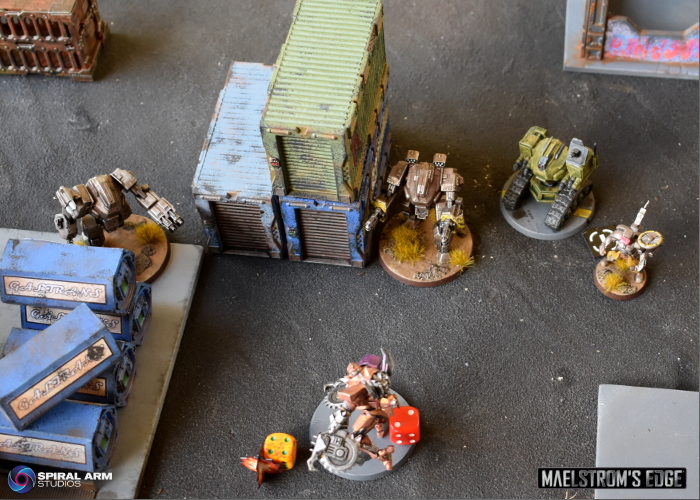
As you can see, the new rules for Maelstrom’s Edge are chock full of improvements...and none of what we’ve presented above even covers the massive rules re-work we’ve done for every single unit in the game. Their rules are both far more streamlined but also laser-focused on allowing them to perform exactly how they’re supposed to. It’s been an extremely long time coming, but we can’t wait for you to try out the new rules and let us know what you think!
Before we go we need to mention the V2 Beta rules, which were available for download on the website while we were working on the print rulebook. If you played the Beta, you probably want to know what has changed in the final version, so you don't have to spend a bunch of time searching for differences in the book. There were two different version of the Beta released. Beta 2.0 was very nearly the finished rulebook. There were a few minor formatting and wording tweaks that don't affect gameplay, and the Epirian Contractor Suppression team had some weapon options added in that were left out by mistake.
There are some more significant differences from the Beta 1.0, so if you only played that version of the Beta, you might want to spend some time going back over the rulebook. There were quite a lot of sections reworded for better clarity. Artarian Remnant units received a bunch of point drops, increased SHO stats on some weapons and some revisions on various abilities and Faction Objectives. Some units for upcoming models in the production queue were added for most factions - The Brutus for the Remnant, Epirian Master Handlers, and Broken Bikers and Skoti Streamweavers. A few Broken units also received some additional gear options (also in the production queue!). Overall gameplay remains the same, but a lot of little details changed to make things clearer or work better based on early player feedback.
The Maelstrom's Edge V2 rulebook is now available! Grab your copy from the Maelstrom's Edge webstore now!

If you have any thoughts on the new rules, pop on over to the Comm Guild Facebook group, or start up a thread in the Maelstrom's Edge section on the Dakka Dakka forums. We welcome any feedback, and would love to hear how everyone's forces stack up in the new rules!
Faction Focus - The Kaigus Pact.
Posted on Wednesday Sept 17, 2025 at 05:00pm in The Kaigus Pact
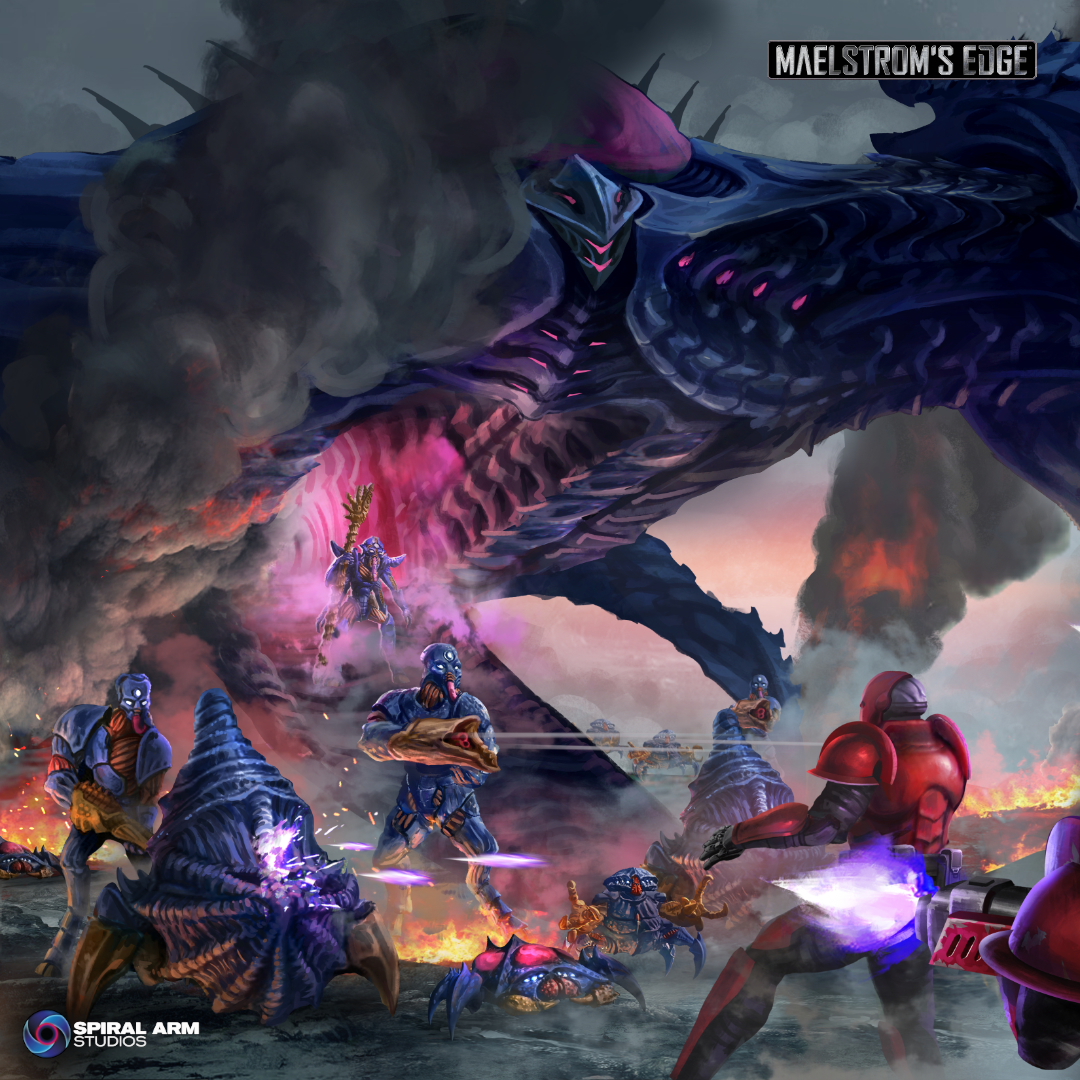
The relative lack of raw materials in deep space and the prowess of the Kaigus in manipulating biotechnology inevitably led to their weapons and technology all using biological processes. Traditional bullets and more technological weapons like lasers are eschewed for rifles that have bio-engineered ligaments for throwing projectiles, poisonous gases and darts, gels that expand and suffocate or strangle their target and other exotic oddities. Microscopic organisms known as namites are controlled by Biologis adepts, able to consume, process and regurgitate organic matter. Operating en masse, these namites can decompose an object and spit it back out as something entirely new within moments. With training, Kaigus are able to control these swarms telepathically, coordinating the namites to construct physical matter to their design. The Biologis continually develop and catalogue a number of “thrall species”, created relatively easily using namites and designed to fulfill important roles within Kaigus society. The genetic blueprints for thrall species include a predisposition to follow telepathic commands and an innate knowledge of the vocation they have been created to fulfill.
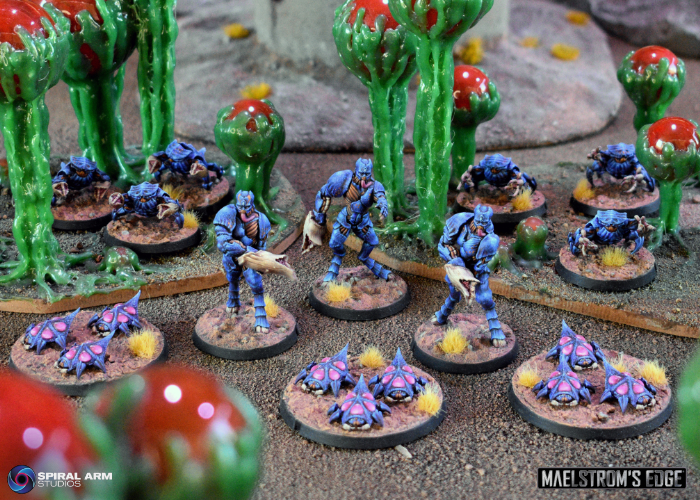
On the table, the Kaigus Pact work quite differently to other factions. Forces are composed of a mix of Kaigus and Thrall species, designed to fill different combat roles. Heavier weaponry is carried by the Kaigus troops, while Tamakin act as lightly armed harassment troops, or melee-equipped close combat units. Explosive or vapor-emitting Krii skitter around the enemies' feet while massively armored Orakan use their carapace as a shield for their progenitors.
Most notably, Biologis and other Kaigus units are able to spawn thrall units directly onto the battlefield. The Hypergenesis ability allows Kaigus Pact commanders to skip the normal reinforcement bidding process. Instead, specific models can spend a fixed number of command points to spawn a thrall unit within 9". Through judicious use of command points, a shrewd commander can get their forces directly into the action when and where they are most needed, overwhelming the opposition with waves of thralls.
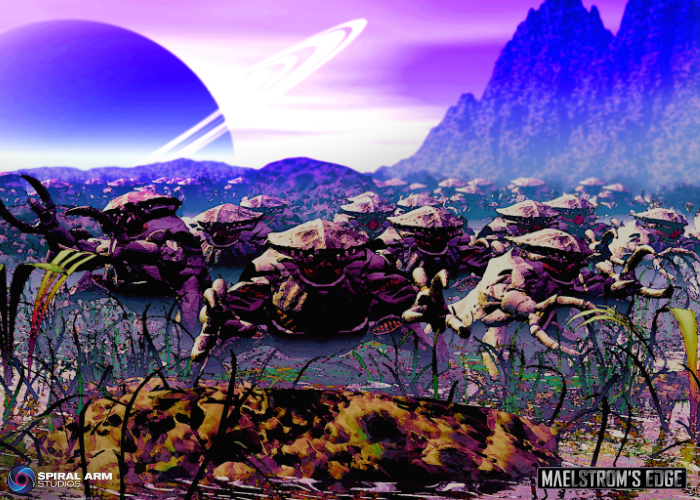
We'll be revealing more about the Kaigus Pact and releasing their first models over the coming weeks. Stay tuned!
The Maelstrom's Edge V2 rulebook is now available! Grab your copy from the Maelstrom's Edge webstore now!

